
Title is Here
Your abstract is here
- Abstract Generator
Abstract generator lets you create an abstract for the research paper by using advanced AI technology.
This online abstract maker generates a title and precise overview of the given content with one click.
It generates an accurate article abstract by combining the most relevant and important phrases from the content of the article.
How to write an abstract for a research paper?
Here’s how you can generate the abstract of your content in the below easy steps:
- Type or copy-paste your text into the given input field.
- Alternatively, upload a file from the local storage of your system.
- Verify the reCAPTCHA.
- Click on the Generate button.
- Copy the results and paste them wherever you want in real-time.
Features of Our Online Abstract Generator
Free for all.
Our abstract generator APA is completely free for everyone. You don’t have to purchase any subscription to abstract research papers and articles.
Files Uploading
To get rid of typing or pasting long text into the input box, you can use this feature.
This will allow you to upload TXT, DOC, and PDF files from the local storage without any hurdles.
Create Abstract and Title
This abstract creator online makes it easy for you to generate a title and precis overview of the given text with one click.
It takes the important key phrases from the content and combines them to create an accurate abstract with advanced AI.
Click to Copy
You can use this feature of our online abstract maker to copy the result text in real-time and paste it wherever you want without any hassle.
Download File
This feature lets you download the abstracted text in DOC format for future use just within a single click.
No Signup/Registration
This free text abstraction tool requires no signup or registration process to use it. Simply go the Editpad.org , search for the Abstract Generator, open it, and enter your text to create an abstract of any text within seconds.
Other Tools
- Plagiarism Checker
- Paraphrasing Tool
- Reverse Text - Backwards Text Generator
- Small Text Generator - Small Caps / Tiny Text
- Upside Down Text Generator
- Words to Pages
- Case Converter
- Online rich-text editor
- Grammar Checker
- Article Rewriter
- Invisible Character
- Readability Checker
- Diff Checker
- Text Similarity Checker
- Extract Text From Image
- Text Summarizer
- Emoji Translator
- Weird Text Generator
- Stylish Text Generator
- Glitch Text Generator
- Cursive Font Generator
- Gothic Text Generator
- Discord Font Generator
- Aesthetic Text Generator
- Cool Text Generator
- Wingdings Translator
- Old English Translator
- Online HTML Editor
- Cursed Text Generator
- Bubble Text Generator
- Strikethrough Text Generator
- Zalgo Text Generator
- Big Text Generator - Generate Large Text
- Old Norse Translator
- Fancy Font Generator
- Cool Font Generator
- Fortnite Font Generator
- Fancy Text Generator
- Word Counter
- Character Counter
- Punctuation checker
- Text Repeater
- Vaporwave Text Generator
- Citation Generator
- Title Generator
- Text To Handwriting
- Alphabetizer
- Conclusion Generator
- List Randomizer
- Sentence Counter
- Speech to text
- Check Mark Symbol
- Bionic Reading Tool
- Fake Address Generator
- JPG To Word
- Random Choice Generator
- Thesis Statement Generator
- AI Content Detector
- Podcast Script Generator
- Poem Generator
- Story Generator
- Slogan Generator
- Business Idea Generator
- Cover Letter Generator
- Blurb Generator
- Blog Outline Generator
- Blog Idea Generator
- Essay Writer
- AI Email Writer
- Binary Translator
- Paragraph Generator
- Book Title generator
- Research Title Generator
- Business Name Generator
- AI Answer Generator
- FAQ Generator
- Active Passive Voice Converter
- Sentence Expander
- White Space Remover
- Remove Line Breaks
- Product Description Generator
- Meta Description Generator
- Acronym Generator
- AI Sentence Generator
- Review Generator
- Humanize AI Text
- AI Translator
- Excel Formula Generator
- AI Prompt Generator
Supported Languages
- Refund Policy
Adblock Detected!
Editpad offers free tools by showing ads to visitors. Support us by disabling your ad blocker and refreshing the page or you can purchase our Premium Plan to enjoy an ad-free experience.
What do you think about this tool?
Your submission has been received. We will be in touch and contact you soon!

Abstract Generator
Get your abstract written – skip the headache., writefull's abstract generator gives you an abstract based on your paper's content., paste in the body of your text and click 'generate abstract' . here's an example from hindawi., frequently asked questions about the abstract generator.
Is your question not here? Contact us at [email protected]
What are the Abstract Generator's key features?
| ✂️ Copy & paste | Copy the body of your paper to generate an abstract fast. |
| 🙌 Free to use | No payment required, completely free! |
| 🔒 Safe & secure | Your data is fully encrypted and never stored. |
| 👨💻 API access | API access to the Abstract Generator on request. |
Abstract Generator
0 Sentence 0 Words
AI Abstract Generator
Creating abstracts can be a challenging task that demands a meticulous approach. It involves carefully dissecting your entire paper and scrutinizing each section to ensure that the vital points are adequately covered while avoiding unnecessary details.
However, despite their difficulties, abstracts play an exceptionally significant role. If your goal is to get your work published, mastering the art of abstract writing becomes essential. Additionally, many academic assignments necessitate the inclusion of an abstract, making it a crucial component of the overall scholarly development process.
| Quickly Generates Abstracts | |
| 😍 Abstracts | Articles, Paragraphs & Sentences |
|---|---|
| 👨🏼🎓 Users | Students, Professionals & Writers |
| 💰 Pricing | 100% Free |
What is an Abstract?
An abstract is a summary of a document, highlighting the full text's main ideas, key points, methodology, results, and conclusions. Its purpose is to quickly understand the document's content without reading the entire text. Abstracts are commonly used in academia and research to help readers assess the relevance and significance of a work.
What are the various structures of an Abstract?
Abstracts can have two main structures:
Structured Abstract:
It follows a specific format with sections like background/objective, methods, results, and conclusion.
Unstructured Abstract:
This format allows more flexibility and is often used in humanities and social sciences.
Both structures serve the purpose of providing a concise overview of the document's main content and findings.
How SpinBot's AI Abstract Generator Tool works?
To use SpinBot's AI Abstract Generator APA, follow the steps below:
Copy and paste the content or upload the document you want to generate an abstract from.
For more accuracy click on Advance Summarize
Remember that SpinBot's Free AI Abstract Generator APA utilizes advanced natural language processing techniques to generate abstracts, but it is always a good idea to review and refine the generated abstract to ensure it accurately represents the original document's content and meets your specific requirements.
Who are the users of SpinBot's Ai Abstract Generator?
SpinBot's AI Abstract Generator is a versatile tool that caters to a wide range of users seeking to create concise and informative abstracts. They include:
SpinBot's AI Abstract Generator assists students in creating well-structured abstracts for their academic assignments, research papers, and projects.
... Read More
It supports teachers in guiding students to develop clear and concise abstracts, enhancing their understanding of abstract writing conventions and facilitating effective communication.
Researchers
Researchers can generate informative abstracts for their studies, enabling them to quickly and accurately summarize their research and share key insights.
It provides bloggers with a convenient tool to create engaging abstracts for their blog posts, captivating readers and giving them a preview of the content.
News Writers and Columnists
SpinBot's AI Abstract Generator helps news writers and columnists craft compelling abstracts for articles, ensuring readers can quickly grasp the main points.
It supports podcasters in creating concise and attention-grabbing abstracts for their episodes, enticing listeners, and summarizing the topics covered.
What are the features of SpinBot's AI Abstract Generator?
Besides its impressive speed, SpinBot's Abstract Creator offers the advantage of being highly accessible. It has been optimized for mobile and desktop usage, allowing users to access the tool from anywhere. Furthermore, the AI abstract generator has the following features:
Generates Abstracts Instantly
SpinBot's AI Abstract Generator allows users to generate abstracts instantly, eliminating the need for time-consuming manual summarization and accelerating the abstract creation process, saving valuable time and effort.
Increases Productivity
By automating the abstract generation process, SpinBot's AI Abstract Generator boosts productivity, enabling users to quickly create high-quality abstracts and focus their time and energy on other important tasks.
Uses AI & ML Technology
Powered by advanced AI and ML technologies, the tool ensures accurate analysis and extraction of key information, resulting in well-crafted abstracts that effectively summarize the content.
Protects Data Privacy
SpinBot prioritizes data privacy and security. The AI Abstract Generator provides a secure platform where users can generate abstracts without worrying about their confidential or sensitive information being compromised or stored.
Remains Free to Use
SpinBot's AI Abstract Generator is available for free, offering accessibility to all users without any cost involved. Users can take advantage of its features and generate abstracts without any financial barriers or restrictions.
How users can create Abstracts for research papers?
Here is a step-by-step guide to writing an abstract:
Step 1: Draft your research paper
Begin by writing your paper, saving the abstract for the end so you can accurately summarize the findings.
Step 2: Review abstract requirements
Familiarize yourself with any specific requirements, such as length or style, if you're writing for publication or a work project.
Step 3: Tailor the abstract to your target audience
Take into account your audience and the intended publication. Adapt the language and level of detail accordingly.
Step 4: Introduce the problem
Start by explaining the problem your research addresses or aims to solve, including the main claim or argument and the scope of your study.
Step 5: Outline your research methods
Describe the methods you employed in your study, including the research conducted, variables considered, and approach taken. Support your assertions with evidence.
Step 6: Highlight the research findings
Share the general findings and answers derived from your study. If necessary, highlight the most significant results.
Step 7: Summarize
Conclude your summary by discussing the meaning of your findings and emphasizing the paper's importance. In the case of an informative abstract, also address the implications of your work.
By following these steps, you can effectively write an abstract that provides a concise and informative overview of your research paper.
Hear what our clients say
Don't just take our word for it, hear what people have to say about us.

What not to say in an abstract?
It is important to avoid providing excessive background information, detailed methodology, extensive citations, subjective statements, personal opinions, or ambiguous language in an abstract. The abstract should focus on conveying the key findings, main arguments, and implications of the research concisely and objectively.
What are the 4 C's of abstract writing?
The 4 C's of abstract writing are clarity, conciseness, completeness, and coherence. Clarity ensures that the abstract is easy to understand, conciseness involves presenting information succinctly, completeness includes covering all key aspects, and coherence ensures that the abstract flows logically and cohesively.
Why is writing an abstract so hard?
Writing an abstract can be challenging due to the inherent difficulty of condensing a complex and detailed content into a concise and coherent summary. It requires careful selection of information, balancing brevity with clarity, and effectively capturing the essence of the work while maintaining its relevance and significance.
What tense should be used in an abstract?
The present tense is commonly used in abstracts to describe the research findings, methodology, and conclusions. However, the specific tense usage may vary depending on the field or journal guidelines. It is recommended to consult the specific guidelines or conventions of the target publication for precise tense usage.
What is the first step in writing an abstract?
The first step in writing an abstract is thoroughly reading and understanding the entire document. Familiarize yourself with the research question, objectives, methodology, major findings, and conclusions. These steps help you identify the key elements that must be included in the abstract and ensure a comprehensive and accurate summary.
What are other tools by SpinBot?
Apart from the free abstract generator, SpinBot offers several other useful tools. These include the Article Rewriter, which helps paraphrase and rewrite text; the Grammar Checker, which identifies grammar and spelling errors; and the Word Counter, which provides accurate word and character counts for text.
Research Paper Abstract Generator
Writing the abstract for your research paper, dissertation, or book chapter is usually one of the final steps before you submit your work. It’s also the activity that many students and researchers find most difficult. A strong abstract must be clear, succinct and informative, but how do you decide what to include?
Structuring your abstract
Many journals require the abstract to be structured according to
whereas the abstract for your dissertation or chapter may just be a short narrative paragraph. Either way, the abstract should contain key information from the study and be easy to read. Creating an abstract is as much an art as a science.
Happily, Scholarcy can help by identifying exactly the right information to include in your abstract.
Abstract in numbers
4 steps to generate an abstract with scholarcy, upload your article.
Simply upload your article to Scholarcy Library to generate a summary flashcard that outlines your research and contains the information needed to create your abstract.
View Scholarcy Highlights
The Scholarcy Highlights tab contains 5-7 bullet points comprising the background to the study, the key findings, and the conclusion.
View Scholarcy Summary
If your paper contains standard IMRaD sections, then the Scholarcy Summary will automatically be structured to follow these headings and will include any study objectives that you have written.
And the Study subjects and participants tab extracts key information about study participants, interventions, and quantitative results. Perfect for your abstract!
Try Smart Synopsis
Alternatively, for your dissertation or book chapter, you can use our Smart Synopses tool to create a more naturally flowing, narrative abstract.
What People Are Saying
“Quick processing time, successfully summarized important points.”
“It’s really good for case study analysis, thank you for this too.”
“I love this website so much it has made my research a lot easier thanks!”
“The instant feedback I get from this tool is amazing.”
“Thank you for making my life easier.”
Privacy Overview
Free Abstract Generator
Make an abstract for your paper in 4 steps:
- Choose between a simple and an advanced option
- Paste the text or add the details
- Click “Generate”
- Check and copy the result
Your abstract may be:
- ⭐️ The Tool’s Benefits
- 🤔 Why Use Our Tool?
📝 What Is an Abstract?
- ✍️ How to Write It
- ✨ Abstract Example
🔗 References
⭐️ abstract generator: the benefits.
| 🌐️ 100% online tool | There is no need to download any apps on your device. |
|---|---|
| 🆓 100% free of charge | This abstract maker for students is absolutely free. |
| 🤗 100% user-friendly | The interface of this tool is intuitive and easy to use. |
| 🎓 Made for students | This online abstract maker is made for educational purposes. |
🤔 Why Use Online Abstract Generator?
Having trouble writing an abstract? You’re not alone.
Crafting an abstract can be problematic, especially when dealing with voluminous work. After all, converting a 100-page academic paper into 150 words is not an easy task. And this is where an abstract maker can help you immensely.
The amount of time you’ll save by relying on a machine to do the work for you is huge. Not to mention the result will be entirely error-free. No logical, grammatical, or other mistakes will spoil your piece.
Sounds interesting? Then, keep reading to learn more about abstracts and our generator.
An abstract is a brief summary of a work. Usually, it's a single paragraph containing 150 to 250 words. It describes all the key points and elements of an article, essay, or work of any other format.
Keep in mind that an abstract merely describes a text. It shouldn’t be an evaluation or an attempt to defend the paper. Instead, it’s just an overview.
Structure of an Abstract
An abstract is not a simple summary. It has a specific structure and should contain the following elements:
- The main issue . Describe the problem you are trying to solve with your research.
- The background . Include everything the reader needs to know before delving into your text.
- The goal . Don’t forget to describe the reasons behind your work.
- The methods . Tell the readers how exactly you performed your research.
- The results . What did you discover? If no particular result comes to mind, you can list your arguments here instead.
- The implications . Show the reader how significant your work is.
Remember that an abstract is separate from the rest of the paper. For the reader to get the complete picture of your research, your abstract must include everything listed above.
✍️ How to Write an Abstract
It can be tempting to go and write an abstract right away. But make sure to finish the planning of your work first. You want to write your abstract about your piece's contents, not build the contents around your abstract.
To make the writing process easier, divide it into 5 manageable steps:
- Check the requirements. First off, you need to know how much you are allowed to write. An average abstract is about 150-250 words long, but there is often a strict limit. Make sure to stay within it!
- Establish the goal and the problems of the research. The reader needs to know what your paper will be about right from the get-go. That’s why you need to formulate your thesis and showcase it first.
- Establish the methods. Tell the reader how you did your research. Don’t go in too deep: simply describe the methods without unnecessary details.
- Describe the results. Write a couple of sentences about the outcome of your investigation.
- Write a conclusion. Address the issue you established in the second step. You might also want to mention your work’s limitations regarding your research samples or methods. Try to give the reader a clear understanding of your goal and how you achieved it.
Want to make the process even easier? Use our abstract tool! Online generators like ours will help you craft an excellent paragraph in a matter of seconds.
Abstract Writing Tips
Finally, we want to help you make your abstract truly amazing. Check out our best tips below:
- It's best to get to the point immediately and without adding any filler or unnecessary details.
- The less specific your abstract is, the better.
- Check out some examples before you start writing. Sometimes the best way to learn something is to watch how everyone else does it.
- Avoid long sentences or bizarre vocabulary to make an abstract paragraph as concise as possible.
- It’s a great idea to single out some keywords from your outline and put them into your abstract.
- Don't forget about formatting. Any serious academic work has its requirements. Make sure you check them before writing your piece.
Following these simple tips will make you a master of abstract writing.
✨ Free Abstract Sample
As an example, check out this abstract of the article “Bioeffcacy of Mentha piperita essential oil against dengue fever mosquito” by Sarita Kumar:
The Mentha balsamea, or peppermint plant, is a result of cross-breeding between spearmint and water mint. These plants are most commonly used in the area of repelling insects. The following research revolves around peppermint oil insect repellent and its development. As a part of an experiment, we obtained 25 grams of fresh peppermint and, after grinding it, put it in a glass jar with olive oil. The jar was then left for two days in a warm temperate. Next, the oil was strained with a cheesecloth, gathered, and diluted at 70%. It then got separated into three different spray bottles. The test was to put the spray sample into a jar with mosquitoes and equate the result to the same test with a commercial repellant. Thus, we challenged the stereotype of synthetic repellents being more efficient than their analogs made from natural materials.
That will be the end of our guide on abstract writing. Thank you for reading, and make sure to try out our abstract writer tool to get the best results!
❓ Abstract Generator FAQ
❓ how do you write an abstract for a research paper.
You may use an abstract tool and make the writing process entirely automatic. If you can’t use it, write an abstract yourself by describing the following:
- The main problem.
- Background information.
- The end goal.
- Description of methods you used.
- The results of the research.
❓ What are the 5 parts of an abstract?
Parts of an abstract depend on the contents and limitations of your research. The 5 main elements are:
- The introduction
- Research significance
- Method description
❓ What makes a good abstract in a research paper?
A good abstract is one that:
- Meets all the requirements.
- Establishes the problem and main issues of the research.
- Describes the methods you used during the analysis.
- Showcases results of the study.
- Provides a clear conclusion.
❓ How long should my abstract be?
An average abstract is about 150-250 words long. You may often get strict limits that can go above or beyond these numbers. Your supervisor should provide the exact requirements for abstract length. So, make sure to double-check them.
Updated: Jun 18th, 2024
- Writing an Abstract: George Mason University
- Writing an Abstract for Your Research Paper: University of Wisconsin - Madison
- Writing an Abstract: Australian National University
- The Abstract: The University of Toronto

Abstract Generator
This Abstract Generator is basically a guideline for writing abstracts. We have also written an article on how to write abstracts. Go through the post and use our tools to create properly formatted abstracts. Note: An abstract should be between 100 - 250 words.
- Pricing(20% Off)
- Account Center
Convert PDF
More pdf tools, organize pdf, protect pdf, image tools, ai abstract generator.
Page loading...
Auto-generate Abstract for Your Paper
Online free ai abstract generator, streamlined abstract generation for everyone, your file security and privacy are guaranteed..

How to Use AI to Generate Abstracts Online for Free
Step 01. upload your pdf to the ai abstract generator., step 02. ai analyzes pdf and generates summaries., step 03. effortlessly revise the generated abstract with ai., make ai abstract generator work efficiently for you, summarize academic studies effortlessly..

Generate informative abstracts for diverse content types.

Swiftly extract abstracts and key points for efficient understanding.

FAQs about Using AI Abstract Generator
What is an abstract.
An abstract is a concise summary that provides an overview of the main points or key elements of a document, research paper, or article.
What makes a good abstract in a research paper?
A good abstract in a research paper should effectively convey the study's purpose, methodology, results, and conclusion concisely and clearly. It should provide a quick overview of the essential information.
Can ChatGPT create abstracts for documents?
ChatGPT can assist in creating abstracts for documents by summarizing text-based content. However, it has a character limit, and for longer documents, it's recommended to use specialized AI tools designed for document summarization.
Is there a free online AI tool that generates abstracts for articles?
Yes, there are free online AI tools that generate abstracts for articles. HiPDF's AI Abstract Generator is one such tool that allows users to create abstracts for articles and other written materials.
What is the best AI abstract generator?
Determining the best AI abstract generator depends on specific needs and preferences. HiPDF's AI Abstract Generator, ChatGPT, and other tools like Sharly AI are among the popular choices, each with unique features.
Is there an AI abstract generator that can craft abstracts for scanned PDFs?
Certainly! For effective abstract generation from scanned PDFs, consider tools equipped with OCR (Optical Character Recognition) and summarization capabilities. PDFelement is a reliable option, utilizing OCR to extract text from scanned documents accurately and then using AI to analyze the PDF for abstract generation. This ensures precise and meaningful abstracts from your scanned PDFs.
More tips for AI Document Summarizer

AI PDF Reader: Summarize, Rewrite, Explain, and Ask PDF Online

Chat with PDF Online for Free Easily

Best AI Content Detector for Free

Top 8 AI PDF Readers 2023

10 Excellent AI PDF Summarizers To Use

AI PDF Summarizer: Summarize PDFs and Text Online Free

Effortlessly Summarize Articles with AI Online

Free Online AI Research Paper Summarizer

Free AI Text Summarizer: Instantly Summarize Any Text Online
Free pdf tools process pdf tasks online..
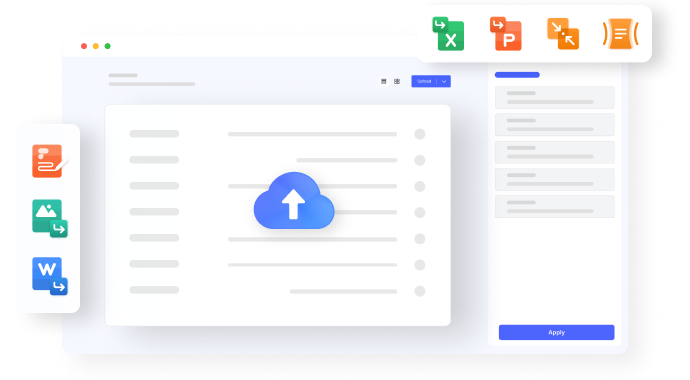
HiPDF Online Tools quality rating:
- Plagiarism Checker
- Paraphrasing
- Essay Generator
- Image To Text
Abstract Generator
Table of Contents
Free Abstract Generator
Prepostseo’s Abstract Generator is an online tool that uses AI technology to help you automatically generate abstracts for your thesis, articles, or research papers. Our abstract maker uses accurate AI and language models to collect the most important phrases from a given content, to generate accurate abstracts.
How to Write Abstract By the Free AI Abstract Generator?
Below are the steps to generate abstracts with the help of our AI abstract maker tool:
Type or paste your writing into the input box of our AI abstract maker.
Simply, hit the “ Generate ” button.
The tool will write the abstract in the output box of the tool.
Finally, “ Copy ” or “ Download ” your abstract.
Free Abstract Generator for Research Papers
- 🚀 Meet Our Abstract Generator
📃 What Is an Abstract?
- ✍️ How to Write an Abstract
- 🫣 7 Mistakes You Should Avoid
🔗 References
🚀 meet our abstract generator for research papers.
The abstract provides a brief overview of the research assignment. So, this part gives a general assessment of the work and encourages the reader to explore it further. Almost every student dealt with the difficult task of condensing their research results into several hundred words. But that’s not a problem anymore!
We used artificial intelligence to make a tool that will make your academic life more enjoyable . You can get an excellent example of an abstract specifically for your research paper in minutes. To do this, you need to specify the reason for the research, the problems, and the goals. Also, we recommend mentioning the methodology and your findings to ensure the outcome is accurate. After that, the AI abstract maker will do the rest for you!
Key Reasons to Use Our Online Abstract Generator
Students juggle various assignments and obligations. Research papers are among the most challenging tasks they have to complete. What makes them so difficult is the sheer volume of information and study involved. Dealing with large amounts of material often leaves students drained and incapable of summarizing their work correctly.
Our abstract generator for research papers makes this process more straightforward thanks to several factors:
| ✅ Customization | The platform generates abstracts for all types of papers. |
|---|---|
| ✅ Free use | Our tool is provided completely free of charge. |
| ✅ Speed | The abstract generator produces results in a matter of minutes. |
| ✅ User-friendliness | The summary AI writer is accessible to people from all walks of life. |
Abstracts provide short summaries of larger works, including research papers and dissertations. Readers scan them to decide whether or not they wish to continue reading the rest of the paper. In about 150–200 words, you should state the problem and provide the research goal, results, implications, and used methods.
One should write research abstracts only after the rest of the work is ironed out and ready. While this part of research may seem insignificant, students should take the time to write the abstract well. Doing so lets them identify any flaws in the research methodology and results.
Types of Research Paper Abstracts
Many students believe that abstracts come only in one type. In reality, there are several versions of summaries used in academic circles.
- Critical Abstract . These are the most extensive abstracts, at around 450 words. Unlike other entries on this list, they encourage deep analysis: for example, a discussion about the validity or reliability of their studies. It’s mostly used in social science research .
- Descriptive Abstract . This format is quite similar to informative abstracts but much shorter. On average, this type is only 100 words long and covers the main focus of the studies. Descriptive summaries offer no conclusions or recommendations for further research.
- Highlight Abstract . Students rarely get to use this type, as its primary goal is to get the reader’s attention. Highlight abstracts don’t helpfully summarize papers . Instead, they concentrate on the unique parts of the research, such as its results and conclusions.
- Informative Abstract . This is the most common type used by researchers and writers. It provides primary information about research concepts, methodology, findings, and recommendations. Sometimes, informative research abstracts have keywords listed at the bottom, but this practice is mainly reserved for professional publications.
✍️ How to Write an Abstract in 5 Steps
Despite the incredible versatility of our abstract generator, it’s still important to learn how to make abstracts on your own. We’ve dedicated this part of the guide to the five steps of writing these summaries. So, these instructions will help you create an abstract for any academic paper.
- Write the paper . To create an abstract, you first need a research paper. Create an outline of the study detailing the problem and methods you’ll use to address it. Explain the research methodology, state what information can be extracted from it, and show how the findings apply to the overall field of study.
- Review paper requirements . Once you’re done with the draft, review the criteria provided by the educational institution. Use the supporting documents with instructions, as they can clarify the requirements for the work's style, formatting, and length. Different disciplines require specific styles, so read this information carefully.
- Consider the audience . When working on an abstract, it’s crucial to identify who will be reading it afterward. For example, students often adjust their language to reach the general public and not only their respective professors.
- Write the abstract . Now, write the abstract based on the provided requirements. Use the body of the research to summarize the problem, explain the methods used in the paper , and show what their results were. Finish the summary by telling why your findings are valuable to the study field and what can be done in further research.
- Iron it out . Like with all writing pieces, it's essential to review the abstract and check if it has all the necessary components. The text should be easy to follow, cover all points, and be informative. As the abstract creates the first impression, make it a good one.
Abstract Formats: MLA & APA Styles
Abstract types aren’t the only things students should look out for. In academic settings, several formatting styles detail how the text should look on paper. The majority of US colleges use two popular methods: MLA and APA . Here, we discuss how abstracts look in each of them.
- Abstracts have their own page directly after the title or cover pages.
- In the APA style, the first line on the page is the word “Abstract” in the center without quotation marks.
- The following line in APA abstracts summarizes the critical points of the research. It introduces the main topic, questions, methodology, findings, and conclusions.
- Use double spaces and make the abstract under 250 words.
- Include keywords after the summary in APA format to help people find the work in various databases.
- Start with a sentence that contains the thesis statement and reason for readers to care about the research.
- Use short and simple sentences with precise words and phrases, as the abstract needs to be easy-to-understand.
- Use transitional words and phrases to make the writing flow and connect ideas more efficiently.
- Edit the abstract until it is 5-7 sentences long or under 250 words.
- Avoid using footnotes and citations.
🫣 7 Mistakes You Should Avoid When Writing an Abstract
Writing abstracts is a pretty straightforward process. But it doesn’t mean that everybody is immune from making mistakes, especially after spending days toiling away on a research paper.
There are seven common errors everybody should check before submitting an abstract.
- Making it too long . A summary should concisely describe the whole paper. Avoid repetition and details that have little to do with the research.
- Using chopped-up sentences . Ensure that your paper contains only complete sentences. It makes the work more professional and easier to comprehend.
- Adding too much technical jargon . Keep things simple so that anyone reading the abstract understands what it’s about. It will also make more people check out your paper.
- Not correcting the text . Sometimes, students want to finish a work without editing it too much. Take the time and comb the document for errors and factual mistakes.
- Failing to explain the significance of the research . The first couple of sentences should give readers a clear understanding of why the study is essential.
- Using the wrong tense . It’s recommended that abstracts be written in the past tense. Some academic institutions won’t accept papers with improperly written abstracts.
- Too many adjectives and hyperboles . You aren’t writing a 19th-century novel but an academic paper. The work should reflect that, so avoid using too many literary devices .
We hope you’ve found this article interesting and helpful in your academic pursuits. We also suggest taking a look at our guide for creating an excellent research paper . If you have any more questions about the art of writing abstracts, check out the FAQ section below.
❓ Research Abstract Generator – FAQ
- It’s written for the right audience.
- It's in the past tense and third person.
- Stands alone on the page.
- Has keywords and critical references.
- Reason for writing it and the importance of the research.
- Problematics the work attempts to solve.
- Methodology behind the study.
- Results backed by specific data.
- Practical and theoretical applications of the findings.
Updated: Oct 25th, 2023
- What Exactly is an Abstract? – Regents of the University of Michigan
- Abstract and Keywords Guide. – American Psychological Association
- Writing an Abstract. – The University of Melbourne
- Six Steps to Write an Abstract. – The University of Alabama
- How To Write an Abstract in 7 Steps (With an Example). – Indeed
- MLA Formatting: How Do I Do: An Abstract. – Warner Pacific University Library
- Abstracts. – The Writing Center, University of North Carolina at Chapel Hill
- Free Essays
- Writing Tools
- Lit. Guides
- Donate a Paper
- Q&A by Experts
- Referencing Guides
- Free Textbooks
- Tongue Twisters
- Job Openings
- Video Contest
- Writing Scholarship
- Discount Codes
- Brand Guidelines
- IvyPanda Shop
- Online Courses
- Terms and Conditions
- Privacy Policy
- Cookies Policy
- Copyright Principles
- DMCA Request
- Service Notice
This article offers an excellent generator for students to craft compelling abstracts. Also, you can explore our guide and tips on writing an abstract for research papers. Learn how to streamline the abstract-writing process and ensure your work gets the attention it deserves.

~3 min read
Revolutionize Your Lab Work with the Brand-New AI Abstract Generator Tool!
Mindgrasp recently released apa abstract generator.
published 1/10/2023 by Mindgrasp
Big names like Chegg, ChatGPT, and Quizlet have taken loads off of students’ backs for years. We know how painful it is watching peers breeze through their homework plugging in each question and getting neat answers and examples of work.
Finally, researchers’ calls have been answered with an abstract summary generator. The tool for simplifying the scientific writing process is here and it’s powered by Artificial Intelligence. AI has come a long way and it’s normal to be skeptical of the new technology. We challenge you to synthesize your next report faster than Mindgrasp’s automatic abstract maker. Using state-of-the-art tech you’re able to create an abstract by pasting long text from your APA report, other online abstracts, research sources, and notes right into the software. Doing this cuts down on the countless hours spent combing through your own lab jargon to simplify and write an abstract. If you haven’t saved hours of time on your writing, we are willing to bet you couldn’t write a better summary quicker. No more stressing over plagiarism! With an abstract generator tool, you can get completely original outputs and stay on the right side of academic integrity. The text output is written at a professional academic writing level so there are also no worries a professor wouldn’t take this abstract generator’s APA citing seriously. Try out the advanced tools of the future! In just a few moments, you can save hours of work on your next report.
WANT TO SAVE TIME READING LONG RESEARCH ARTICLES?
- Automated Note-Taking
- AI powered Q&A
- Abstract generator
- Quick Summarizer


Research Voyage
Research Tips and Infromation
Top 10 AI-Based Research Paper Abstract Generators
In today’s academic and professional arenas, the ability to succinctly and accurately summarize extensive research is paramount. Abstracts serve as the gateway to the wealth of knowledge contained within scholarly papers, providing readers with a snapshot of the research’s scope, methodology, and findings. Crafting an effective abstract is an art, one that requires precision and clarity, yet it remains a daunting task for many. This is where advanced AI-powered tools come into play, revolutionizing the abstract creation process.
An abstract generator is an AI-powered tool designed to create concise and coherent summaries of extensive texts, such as research papers, theses, and articles. Utilizing advanced algorithms, these generators analyze the main content, extract key points, and produce a summary that adheres to specific academic standards, such as the APA format. They are particularly useful for students, researchers, and professionals, providing a quick, efficient, and accurate way to generate abstracts that effectively communicate the essence of the original document.
Abstract generators harness the power of artificial intelligence to transform lengthy, complex texts into concise, coherent summaries. These tools not only save valuable time but also enhance the quality and consistency of abstracts, adhering to stringent academic standards such as the APA format. They cater to a diverse audience, including students, researchers, and professionals across various disciplines, making the abstract writing process more efficient and accessible.
From ensuring unbiased abstracts to providing customizable options, AI abstract generators are equipped with advanced features that simplify the summarization process. Whether you need an abstract for a research paper, thesis, or article, these tools offer a seamless solution, allowing you to focus on the core content of your work while they handle the summarization.
Explore the transformative capabilities of abstract generators from leading platforms. These innovative tools are designed to meet the rigorous demands of academic writing, providing an invaluable resource for anyone striving to create impactful and precise abstracts. Dive into the future of abstract creation and discover how these tools can elevate your academic and professional endeavours.
Here’s a curated selection of 10 top-tier AI abstract generators poised to elevate your research game:
How It Works:
Key features:, make an abstract for your paper in 4 steps:, advanced fields:, idea generation and structuring, academic language refinement, feedback and revision suggestions, ideal users of abstract generator services, guidelines for using abstract generator.
- StudyCorgi: Best AI Abstract Generator - Online & Free
The Best APA Abstract Generator from PhDResearchProposal.org
Essaygpt: how to create an abstract for free, ai abstract generator from paraphrasing-tool.com, abstrazer: automatic abstract generation simplified, writecream’s ai scientific paper abstract generator: revolutionizing research abstracts effortlessly.
Experience the future of effortless scientific paper abstract creation with WriteCream’s groundbreaking AI Scientific Paper Abstract Generator. This versatile tool leverages artificial intelligence (AI) technology to automatically generate concise and informative abstracts for scientific research papers. Whether one is a scientist, a science scholar, or a researcher, WriteCream’s AI Abstract Generator simplifies the path from idea to impactful abstract formation.
- Access the Tool : Users can visit the WriteCream website and navigate to the abstract paper Generator page.
- Enter Details : Important details about the scientific paper, key features, and any special offers or benefits to highlight in the abstract are included.
- Select Tone and Style : Users choose the tone and style of the abstract paper from available options. The generator adjusts the content to reflect the chosen tone, whether formal, informal, amusing, or professional.
- Copy & Paste : After selecting the tone, users click “Generate” once they have entered the required information and decided on the tone. The final sample can be copied, pasted, or downloaded.
- One-Click Generation : Users can generate a well-crafted abstract with just a single click, saving time and effort in manual summarization.
- Customization : Some AI Abstract Generators allow users to customize the length and level of detail in the generated abstract to meet their specific needs.
- Accuracy : Striving for high accuracy in representing the main ideas and findings of the research paper.
- Consistency : Ensuring that the abstract’s style and terminology are consistent with the content of the paper.
- Multilingual Support : Depending on the tool, it may support various languages and translation options, making it versatile for international researchers.
- Revision and Editing : Users can often review and edit the generated abstract to fine-tune it according to their preferences.
WriteCream’s Scientific Paper Abstract Generator is a powerful tool that simplifies the process of creating clear and concise abstracts for research papers, benefiting content editors aiming to provide informative and well-structured content. To learn more, users can visit the WriteCream website and create an account today.
URL: https://www.writecream.com/ai-scientific-paper-abstract-generator/
HiPDF AI Abstract Generator: Streamlined Abstract Generation for Every Researcher
Revolutionize the way you create abstracts with HiPDF’s AI Abstract Generator. Powered by advanced AI technology, this tool effortlessly summarizes your paper content and generates an abstract complete with keywords and key points. Experience a seamless abstract generation process with HiPDF’s user-friendly interface.
- Effortless Summarization : Automatically summarize your PDF papers with ease, saving valuable time and effort in abstract creation.
- User-Friendly Interface : Whether summarizing entire documents or crafting concise abstracts, HiPDF’s AI Abstract Generator simplifies the process for every researcher.
- International Certifications : As a member of the PDF Association, HiPDF ensures international authoritative certifications, including ISO/IEC 27001 and SSI SECURE, guaranteeing privacy and file security.
- Privacy Assurance : All files uploaded to HiPDF are permanently deleted within 60 minutes after processing, ensuring user privacy and data security.
- Upload Your PDF : Simply upload your PDF document to the AI Abstract Generator, supporting various document types like articles and research papers.
- AI Summarizes Your PDF : After uploading, the AI abstract generator automatically creates a brief summary with keywords and key sentences.
- Effortless Revision : If you’re unsatisfied with the generated abstract, prompt the AI to revise and create a better one for your paper using the Chat with PDF feature.
Experience the power of AI-driven abstract generation with HiPDF’s AI Abstract Generator. Start streamlining your research workflow today.
URL: https://www.hipdf.com/ai-abstract-generator
Abstract Creation Using 4Author Online Service
4Author’s online service revolutionizes the process of abstract creation, allowing researchers to focus on the main text of their manuscript without worrying about the structure and standards of the abstract. This tool ensures adherence to various style requirements and eliminates common mistakes in abstract writing.
- APA Style (APA Style Abstract)
- MLA Style (MLA Style Abstract)
- American Academy of Science requirements (AAS Abstract)
- GOST (All-Union State Standard) Standard (GOST Abstract)
- Emerald Publishing Office requirements (requirements of the scientific journal “Business Inform”)
- Languages : Abstracts can be created in English, Russian, and Ukrainian.
- Input Language and Title : Provide the language and title of your work.
- Authors’ Information : Include the surnames and initials of the authors and co-authors.
- Relevance : Summarize the importance of the investigated problem.
- Statement of the Problem : Describe the problem the article addresses.
- Solutions : Outline specific steps aimed at solving the given problem.
- Results : Present the results achieved during the study or a generalization of the full text.
- Conclusions : Describe the prospects of implementing the results in practice.
- Keywords : Provide words and phrases for search engine optimization.
- Word Count and Preview : The average word count of the abstract is displayed at the bottom of the form. Users can preview and save the brief description in their personal account. If necessary, abstracts can be edited and other tools available to registered users can be utilized.
Educational Use : The service is suitable for educational institutions, making it possible to compose abstracts for graduation papers, term papers, or any other manuscript requiring an abstract, regardless of the subject.
4Author’s online service simplifies the abstract creation process, ensuring compliance with various standards and enhancing the efficiency of researchers. To learn more and start creating abstracts effortlessly, visit 4Author’s online service .
URL: https://www.4author.com/en/annotation/
ASSIGNZEN: Free Abstract Generator
Struggling with crafting the perfect abstract? ASSIGNZEN has got you covered with its powerful, free abstract generator. Designed to assist you in creating plagiarism-free papers tailored to your instructions, this tool makes the abstract-writing process straightforward and efficient.
- Choose between a simple and an advanced option: Start by selecting the mode that best suits your needs.
- Paste the text or add the details: Input your paper’s content or key details into the generator.
- Click “Generate”: Let the AI work its magic to produce a concise and informative abstract.
- Check and copy the result: Review the generated abstract and copy it for use.
For those opting for the advanced option, ASSIGNZEN allows you to provide specific details to enhance the accuracy and relevance of the abstract:
- Explain the research context and background.
- Word count: 40-500 words.
- Describe the problem and aim of your study.
- Outline your research methods.
- List your research findings.
- Add your conclusion and discuss the significance of your findings.
Using these detailed prompts ensures that the generated abstract accurately reflects the core components of your research, providing a clear and comprehensive summary.
Explore ASSIGNZEN’s free abstract generator and streamline your research writing process here.
URL: https://assignzen.com/free-writing-tools/abstract-generator/
Yeschat: Abstract Generator – AI-Powered Abstract Creation
Yeschat’s Abstract Generator is an AI-powered tool designed to assist university and college students in crafting high-quality essay abstracts across various subjects and educational levels. The core purpose of this tool is to streamline the abstract writing process, making it more efficient and effective by providing structured guidance, generating ideas, and refining academic language. This assistance is crucial for students aiming to produce compelling and concise summaries of their extensive essays or research papers. For example, a student working on a complex thesis about climate change impacts on coastal ecosystems can use Abstract Generator to distill their research into a succinct abstract that highlights key findings, methodology, and the significance of their work. This tool adapts to different learning styles and academic disciplines, ensuring broad applicability and support for a wide range of academic writing tasks.
Main Functions of Abstract Generator
- Generating a thesis statement and outlining key points for an abstract on the socio-economic effects of urbanization.
- A student is struggling to condense their urban studies essay into an abstract. Abstract Generator suggests a concise thesis statement and helps organize their thoughts into a structured abstract format.
- Enhancing the language of an abstract for a paper on quantum computing to ensure clarity and precision.
- A postgraduate student needs to refine the language of their abstract to meet the publication standards of a leading academic journal. Abstract Generator assists by suggesting academic phrases and terminology specific to their field of study.
- Providing constructive feedback on a draft abstract for a literature review on postcolonial theory.
- A student has drafted an abstract for their literature review but is unsure about its quality. Abstract Generator reviews the draft, offering feedback and specific suggestions for improvement to enhance readability and impact.
- University and College Students: Students at various educational levels, especially those engaged in writing essays, research papers, and theses across different disciplines. They benefit from Abstract Generator’s support in crafting precise and compelling abstracts that effectively summarize their work.
- Academic Researchers: Early-career researchers and graduate students who are new to publishing in academic journals. Abstract Generator can help them articulate the significance of their research findings clearly and concisely, making their work more accessible to a broader academic audience.
- Non-Native English Speakers: Students and researchers for whom English is a second language may find it challenging to express complex ideas in academic English. Abstract Generator aids in enhancing their abstracts’ clarity and academic tone, thereby improving their chances of publication or academic success.
- Visit yeschat.ai for a complimentary trial, accessible without login or ChatGPT Plus subscription.
- Select the academic subject or research area for which you need to generate an essay abstract.
- Provide specific details about your essay, including thesis, research methods, findings, and conclusions.
- Use the ‘Generate Abstract’ feature to create a concise and academically rigorous abstract based on your input.
- Carefully review the generated abstract, making necessary edits to ensure it accurately reflects your work and meets academic standards.
By leveraging Yeschat’s Abstract Generator, students and researchers can save time, reduce errors, and enhance the overall quality of their academic abstracts, making their work more impactful and accessible. For more information, visit here:
URL: https://www.yeschat.ai/gpts-2OToXaRBW2-Abstract-Generator
StudyCorgi: Best AI Abstract Generator – Online & Free
How to Use Our Abstract Generator Online:
- Paste your text into the empty field.
- Fill in all 5 advanced fields if necessary.
- Press “Generate.”
Why Use Our AI Abstract Generator?
StudyCorgi’s AI Abstract Generator is one of the best study tools you can find online. Here are its most notable advantages:
- 100% Free: Use it at no cost!
- Intuitive Design: It has an excellent user-friendly interface.
- Readily Available: You don’t have to create an account or download anything to use our generator.
- No Limits: You can generate an unlimited number of abstracts.
- Various Uses: Our app can work with any academic subject and topic.
An AI bot will generate an abstract for you, making it easier and quicker to create compelling summaries for your academic work. Experience the efficiency and convenience of StudyCorgi’s Abstract Generator today. For more information, visit StudyCorgi Abstract Generator.
URL : https://studycorgi.com/free-writing-tools/ai-abstract-generator/
Abridgments are challenging. Summarizing a lengthy text into a compact, meaningful introduction that captures the reader’s interest is no easy task. Abstracts are crucial for publication and many class assignments, making them an essential part of the academic process.
Automatic Abridgment Tool
PhDResearchProposal.org offers an online abstract generator to ease this process. This tool simplifies creating abstracts:
- Easy to Use : Paste your text, specify the length, and click “go.” The tool quickly generates a complete abridgment in just a few seconds.
- Time-Saving : You can have a finished abstract in less than ten minutes, or even less than two if used as-is. This allows you to focus more on your paper and less on summarizing it.
- APA Abstract Generator : It helps ensure your abstract meets the required length and guidelines.
Use Abridgments Maker Online
The abstract generator is optimized for both mobile and desktop, making it easily accessible from anywhere. Bookmark the URL and use it on the go. The generator is:
- Smart : Leaves in the most important points.
- Adjustable : Allows customization for better results.
- Helpful : Serves as a model for your own work.
- Accurate : Ensures correct spelling and grammar as long as your original text is error-free.
Actual Structure You Must Follow
The structure of a well-crafted abstract consists of seven components:
- Introduction : Contextualizes your topic and garners interest.
- Discussion : Briefly describes the data generated and its significance.
- Literature Review : Summarizes existing findings and sets the stage for your analysis.
- Abridgment : Identifies the main question and its relevance.
- Methodology : Details the data gathering process using technical terms.
- Results : Presents the analysis and its relation to the main question.
- Conclusion : Summarizes findings and their importance, suggesting potential future steps.
Using the abstract generator from PhDResearchProposal.org, you can create structured, high-quality abstracts effortlessly, saving time and ensuring your work meets academic standards.
URL: https://www.phdresearchproposal.org/abstract-generator/
In today’s fast-paced academic and professional world, the ability to quickly and effectively summarize content is invaluable. EssayGPT’s abstract generator is a powerful tool to help you distill lengthy texts into concise, well-crafted abstracts. Follow these straightforward steps to create an abstract:
- Paste your content into the provided text box.
- Select your preferred language for the abstract.
- Click “Generate” to create an abstract.
EssayGPT’s tool is user-friendly and efficient, making it an excellent choice for researchers and students looking to streamline their abstract writing process. Explore EssayGPT here.
URL: https://essaygpt.hix.ai/tools/abstract-generator
The AI Abstract Generator from Paraphrasing-Tool.com is a versatile tool that simplifies the process of creating abstracts. It adheres to APA guidelines and ensures accurate and unbiased abstracts. Powered by advanced AI technology, it generates abstracts quickly.
The tool is easy to use, with a user-friendly interface that requires no technical expertise. It’s a free abstract generator that can handle a variety of styles, including the APA format. Whether you’re a student, teacher, or employee, this abstract generator is a valuable resource for creating high-quality abstracts.
Unbiased Abstracts
The tool ensures the creation of unbiased abstracts for your research papers, documents, and articles, making your assignments less time-consuming.
Advanced AI Technology
The AI-powered abstract generator utilizes advanced algorithms to summarize your content accurately, producing error-free abstracts based on your content.
Ease and Convenience
The abstract creator offers a user-friendly interface, making it simple and intuitive to generate high-quality abstracts.
100% Free Service
The AI abstract generator is completely free, enabling you to create professional-quality abstracts without any cost limitations.
Working of the AI Abstract Generator Tool
The AI abstract generator is a free tool that saves time and effort by creating accurate, APA-compliant abstracts. It streamlines the writing process by utilizing the AI Abstract Generator model, which automatically generates an abstract based on content summary. This convenient and reliable solution is perfect for students and researchers, allowing them to streamline their abstract writing process.
To use the AI Abstract Generator, follow these steps:
- Copy and paste the content into the input box.
- Click the “Generate Abstract” button to initiate the abstract generation process.
- Wait for the tool to analyze and process the content.
- Once the abstract is generated, it will be displayed on the screen.
- Review the generated abstract and make any necessary adjustments or edits.
- Once reviewed, download or export the results.
URL: https://paraphrasing-tool.com/abstract-generator
Abstrazer stands as a unique platform for generating automatic abstracts for articles, essays, or web pages. Supporting multiple languages, including English, German, French, Spanish, Italian, Russian, Arabic, Chinese, and more, Abstrazer swiftly generates extracts with the most semantically relevant sentences, cutting down the arduous process of abstract writing. Students and researchers can leverage Abstrazer to streamline their research paper abstracts effortlessly. Best of all, Abstrazer is completely free to use.
URL: https://www.nelsenso.net/en/abstract-online.aspx
Visit my article on ” Research Paper Abstract: 10 Simple Steps to Make a Big Difference” for more information writing abstract.
While AI abstract generators offer efficiency, they should complement—not replace—your critical review process. Always review and refine generated abstracts to align with your research and journal guidelines, ensuring accuracy and maintaining academic integrity.
Upcoming Events
- Visit the Upcoming International Conferences at Exotic Travel Destinations with Travel Plan
- Visit for Research Internships Worldwide

Recent Posts
- 05 Quick Review, High Impact, Best Research Journals for Submissions for July 2024
- Top Mistakes to Avoid When Writing a Research Paper
- Average Stipend for Research/Academic Internships
- These Institutes Offer Remote Research/Academic Internships
- How to Include Your Journal in the UGC-CARE List? A Guide for Publishers
- All Blog Posts
- Research Career
- Research Conference
- Research Internship
- Research Journal
- Research Tools
- Uncategorized
- Research Conferences
- Research Journals
- Research Grants
- Internships
- Research Internships
- Email Templates
- Conferences
- Blog Partners
- Privacy Policy
Copyright © 2024 Research Voyage
Design by ThemesDNA.com


Best Abstract Generator: Generate Abstracts For Research Papers
In the ever-evolving landscape of academic research, AI-powered tools are revolutionising the art of abstract writing. Abstrazer, Scholarcy, WriteFull, and ChatGPT are leading the charge, offering students and researchers efficient ways to condense extensive research into concise summaries.
Harnessing advanced AI algorithms, these tools ensure clarity, grammatical accuracy, and relevance, catering to a diverse range of academic needs. Which of these tools are best for you? Let’s find out.
Best Online Abstract Generator Tool
| Automatic abstract generation Advanced AI technology Concise summaries APA formatting Plugins for academic platforms Mobile & desktop compatibility | |
| AI-powered Quick abstract generation Reads full papers Grammatical accuracy Versatile use cases Language editing Free & premium options. | |
| AI-powered abstracts User-friendly interface Free high-quality abstracts Title generator Paraphrasing & formalizing tools Mobile & desktop access. | |
| Data-driven coherence User-prompted abstracts APA formatting AI-assisted writing Complements researcher expertise. |
Abstrazer offers students and researchers a unique platform to automatically generate abstracts for their research papers, cutting down the arduous process of abstract writing.
Given the specific requirements of abstracts, which typically hover between 150 to 250 words, this tool ensures conciseness without omitting key information.

The strength of Abstrazer lies in its advanced AI technology, which streamlines the abstract generation process.
If you’re grappling with summarizing your paper’s key findings and methods, Abstrazer provides a concise summary by eliminating unnecessary details and highlighting only the pivotal points.
It’s been designed to cater to a wide range of users, ensuring a well-structured abstract irrespective of the academic paper’s complexity.
What sets Abstrazer apart is its versatility. For instance, if one’s specific requirement revolves around APA formatting, the abstract generator utilizes advanced AI feature ensures accurate formatting with spot-on language edits.
This online abstract maker is especially handy when the task of abstract creation seems daunting. With a few inputs, Abstrazer simplifies the process of creating compelling abstracts that resonate with the intended audience.
Additionally, this AI-based tool is also available within various academic platforms through plugins, making it a handy tool on both mobile and desktop interfaces.
For those aiming for error-free, high-quality abstracts, Abstrazer is the go-to tool. It promises efficiency, saving precious time and effort, while still ensuring the final output gives the reader an apt snapshot of the research, making the academic journey a tad easier.
Scholarcy, an online abstract generator, offers a solution for students and researchers grappling with the challenge of abstract writing.
With the increasing demand for a tool to create concise summaries, this AI-powered abstract generator has risen to the occasion. While writing an abstract can be challenging, this tool simplifies the process of creating engaging and compelling abstracts for your research paper.
To use this tool, simply upload your academic paper. Within seconds, Scholarcy automatically generates an abstract that’s well-structured and caters to a wide range of users.
Its AI-based technology reads the entire paper, from introduction to conclusion, and provides a concise summary, highlighting key findings and key points without unnecessary details. The resulting abstract is typically between 150 to 250 words, making it apt for publication guidelines.
What makes Scholarcy stand out is its advanced AI technology. This abstract generator APA utilizes advanced algorithms to ensure abstracts are grammatically correct and error-free.
The abstract generator is a versatile tool, ideal for:
- Literature reviews
- Academic articles
For those with specific requirements, Scholarcy offers language edits to ensure conciseness and accuracy. Additionally, the abstract creator offers plugins for both mobile and desktop, making it accessible to a vast audience.
This free abstract generator saves time and effort, eliminating the struggle to write abstracts manually.
One notable feature is the daily quota for free abstract generation, ensuring users can create abstracts without any cost. However, for those requiring more, premium options are also available within the platform.
Writefull is an AI-powered tool designed to aid researchers in creating well-structured abstracts for their academic papers.
It’s no secret that generating an abstract can be challenging; after all, summarizing months or even years of research into a concise summary isn’t easy.
This is where the Writefull’s abstract generator steps in, simplifying the process of creating compelling abstracts by using advanced AI technology.

The online abstract maker allows you to paste content from your research paper – from the introduction to the conclusion – and automatically generates an abstract, honing in on the key points and findings of your work.
The beauty of this tool is its ability to produce high-quality abstracts without any cost. The abstract generator online not only ensures accurate and concise summaries but also saves time and effort, especially for students and researchers who have a tight daily quota or are on tight deadlines.
In addition to abstract writing, Writefull also offers a title generator to help craft the perfect headline for your research paper. The tool caters to a wide range of users, providing a concise summary while removing unnecessary details, ensuring grammatical accuracy and an error-free result.
But Writefull’s features don’t end there. This versatile tool also offers:
- Paraphrasing option
- Aids in language edits, and
- An ‘Academizer’ feature that turns informal text into formal academic language.
Fascinatingly, the abstract generator APA utilizes advanced AI to distinguish content generated by AI from original text, ensuring the authenticity of your work.
Moreover, the platform is accessible both on mobile and desktop and even offers plugins for instant access. For those who prioritize conciseness and accuracy, Writefull is the go-to solution, ready to serve specific requirements and create engaging abstracts within seconds.
ChatGPT, developed by OpenAI, is a potent abstract generator that, when used right, can provide a high-quality abstract tailored to your academic paper.
Its development process is grounded on extensive datasets, which allows the tool to create abstracts that are not only coherent but original.
This AI-powered abstract generator is a versatile tool that can cater to a wide range of users, from students trying to generate an abstract for their thesis to seasoned researchers working on extensive literature reviews.
One of the unique features of ChatGPT is its ability to generate abstracts based on specific prompts provided by the user.
With just a few clicks, ChatGPT automatically generates an abstract, streamlining the abstract writing process and ensuring conciseness. Users have found it helpful, especially when dealing with specific requirements for their abstracts, which often must be between 150 to 250 words.
This AI-based tool ensures the elimination of unnecessary details, highlighting only the key points that give the reader a well-structured summary of the research.
It’s like having an AI writing assistant that helps you write abstracts efficiently.
While ChatGPT simplifies the process of creating abstracts, it’s essential to note that this AI tool should supplement and not replace the expertise of the researcher. It saves time and effort, but the output should always be reviewed for grammatical accuracy and relevance.
In an ever-evolving academic landscape, the introduction of tools like ChatGPT, powered by advanced AI, is a testament to how technology can assist students and researchers in producing error-free, compelling abstracts for their work.
Wrapping Up: Generate An Abstract From A Research Paper Easily
Navigating the realm of academic research, tools like Abstrazer, Scholarcy, WriteFull, and ChatGPT are leveraging advanced AI to simplify abstract creation. Each offers unique features, from automatic abstract generation to specific formatting like APA.
Designed to cater to various users, from students to seasoned researchers, these platforms streamline the abstract-writing process, ensuring concise and coherent summaries. They highlight the potential of AI in academic writing, merging efficiency with quality.

Dr Andrew Stapleton has a Masters and PhD in Chemistry from the UK and Australia. He has many years of research experience and has worked as a Postdoctoral Fellow and Associate at a number of Universities. Although having secured funding for his own research, he left academia to help others with his YouTube channel all about the inner workings of academia and how to make it work for you.
Thank you for visiting Academia Insider.
We are here to help you navigate Academia as painlessly as possible. We are supported by our readers and by visiting you are helping us earn a small amount through ads and affiliate revenue - Thank you!

2024 © Academia Insider

- Start your 7-day free trial
Generate a Research Abstract from a Title
Wordblot has so many potential uses. Within academic writing, a common problem is generating the abstract. So give it a spin and enter a title to see if we can help you with an abstract.
- @WordblotAI
- Privacy Policy
- Terms of Service
© 2021 All rights reserved.
Knowledge Center
- 9 Ways to Get Over Writer's Block
Free AI Abstract Generator
Free ai abstract generator: create concise summaries instantly.
What is the Free AI Abstract Generator?
Our Free AI Abstract Generator is a cutting-edge tool that leverages advanced artificial intelligence and natural language processing (NLP) to provide users with brief, coherent abstracts of extensive texts. Whether you're a student, researcher, or professional, this tool will help you grasp the main points of any document without having to read through the entire content.
Key features:
- Time-Saving: Generate summaries in seconds, saving you hours of reading time.
- High Accuracy: Our AI algorithms ensure that the abstracts accurately reflect the main ideas and arguments of the original text.
- User-Friendly: Simply input your text, and our tool will handle the rest. No technical expertise is required.
- Free Access: Enjoy the benefits of a high-quality abstract generator without any cost.
- Consistency: Unlike human summarizers, our AI maintains consistent quality and style across all generated abstracts.
How Does It Work?
Using our Free AI Abstract Generator is simple:
- Text Input: Copy and paste your document into the provided text box.
- Analysis: Our AI analyzes the text, identifying key themes, concepts, and important sentences.
- Summary Creation: The AI constructs a concise abstract that includes the most critical information.
- Output: Instantly receive a summarized version of your document.
Who Can Benefit?
- Students and Researchers: Quickly understand the gist of academic papers and articles, aiding in efficient study and research.
- Business Professionals: Keep up with industry reports and whitepapers without investing hours in reading. sentences.
- Writers and Editors: Get quick summaries of source materials to aid in content creation and editing.
Why Choose Our Free AI Abstract Generator?
- State-of-the-Art AI: Our tool uses the latest in AI technology to provide the best possible summaries.
- Ease of Use: A straightforward interface ensures that anyone can use the generator with ease.
- Reliability: Count on consistent and high-quality outputs every time.
- No Cost: Access all these features for free, with no hidden charges.
Discover Our FREE AI tools
- AI Abstract Generator
Quickly extract key insights from lengthy documents and delivers concise summaries for efficient comprehension and decision-making.
- AI Conclusion Generator
Effortlessly summarize texts in seconds. Save time with accurate conclusions.
- AI Essay Checker
Ensure flawless writing. Detect errors, improve style, refine structure.
- AI Essay Extender
Expand essays seamlessly. Reach word count goals without compromising quality.
- AI Essay Rewriter
Transform your writing. Enhance readability, ensure originality.
- AI Essay Shortener
Condense essays without losing key points. Deliver concise summaries.
- AI Introduction Generator
Craft engaging introductions effortlessly. Captivate readers from the start.
- AI Outline Generator
Create structured outlines in minutes. Ensure coherence and clarity.
- AI Research Title Generator
Generate compelling titles for research projects. Engage your audience effectively.
- AI Essay Topic Generator
Generate ideas and suggestions for essay topics based on specific criteria or keywords provided.
- AI Text Summarizer
Efficiently grasp key insights. Summarize lengthy documents quickly.
Frequently Asked Questions
Need help? Look through our FAQs for quick answers!
How does StackifyMind work?
Who can benefit from using stackifymind, what language models does stackifymind support, how do i get started with stackifymind, is my data secure with stackifymind, what payment methods are available, can i cancel my subscription anytime, where can i get support if i face issues with stackifymind.
StackifyMind, your all-in-one Document AI App solution. Upload your PDFs and various file formats effortlessly, and interact with our cutting-edge chat AI to seamlessly extract invaluable insights and information.
Copyright © 2024 StackifyMind. All rights reserved.
- Affiliate Program
Earn 40% income for every referral you bring.
- QuillWord AI
- CoWriter AI
- Terms & Conditions
- Privacy Policy
Best AI Abstract Generator: Online & Free
Here is your abstract
If you want to create beautiful abstracts and drastically improve the quality of your research, you've come to the right place. Meet our new mind-blowing AI abstract generator! It will create a fantastic piece of text that incorporates every critical aspect of your research.
- ️🤖 How to Use the Tool
- ️💡 Why Use the Abstract Generator?
- ️🔬 What Is an Abstract?
- ️✅ Abstract Types
- ️✍️ How to Write an Abstract
- ️📝 Abstract Example for Free
- ️❓ AI Abstract Generator FAQ
- ️🔗 References
🤖 How to Use Our Abstract Generator Online
- Paste your text into the empty field.
- Fill in all 5 advanced fields if necessary.
- Press “Generate.”
- An AI bot will generate an abstract for you!
💡 Why Use Our AI Abstract Generator?
Our generator is one of the best study tools you can find online. Here are its most notable advantages:
| 💸 100% free | Use it at no cost! |
|---|---|
| 🤩 Intuitive design | Enjoy the user-friendly interface. |
| 🌐 Readily available | No need to create an account. |
| 🚀 No limits | Generate an unlimited number of abstracts. |
| 💎 Various uses | Works with any academic subject. |
🔬 What Is an Abstract?
An abstract is a paragraph that gives readers a general synopsis of your research's contents and structure. It should include your thesis , main points, methodology, and findings. An abstract is usually 150-200 words in length.
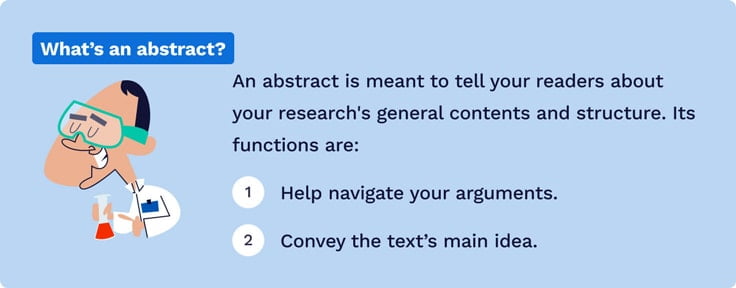
It serves the following purposes:
- Helps to navigate your arguments.
- Allows readers to grasp the main idea from your text quickly.
- Aids in remembering key points from your paper.
✅ Abstract Types
Abstracts come in two general types: informative and descriptive . They differ in terms of components and styles because they have separate goals.
- A descriptive abstract indicates what information is included in your research. It doesn't provide study findings or conclusions. Some view it as an outline of the work rather than a synopsis. Typically, descriptive abstracts are brief, with 100 words or less.
- An informative abstract combines the material provided in a descriptive one (goal, methods, and scope) with the research's findings and conclusions. An informative abstract is usually around 10% of the work in length.
✍️ How to Write an Abstract
Now that you know what abstracts are, it's time to learn how to write them . Just follow our handy step-by-step guide below!
1. Define the Purpose of Your Research
The first step to writing an abstract is clearly outlining your research's general objective and purpose. To do it, answer the following question: What theoretical or practical issue does your study address, and which topic do you want to investigate?
It's better to avoid providing extensive background. Instead, give a brief answer to why your topic is essential. Also, don’t forget to explain all the technical words and terms if you plan to use them in your research.

2. Review the Requirements
You may receive specific requirements from your instructor about the length or style of your project. Neglecting them can result in failing your assignment. That's why it's best to review all the requirements before writing an abstract.
3. Explain the Problem and the Methods
This step requires you to outline a particular issue that your research focuses on and aims to resolve.
- Determine the focus of your study as well as your main arguments.
- Additionally, explain the methodology that you’ve used to make your arguments.
- Don’t forget to mention the evidence that proves your point.
4. Summarize the Findings
Every abstract requires a summary of the research's key findings. If you can’t cover everything, emphasize only the most significant points. Try to draw attention to those aspects that will help the reader understand your conclusions.
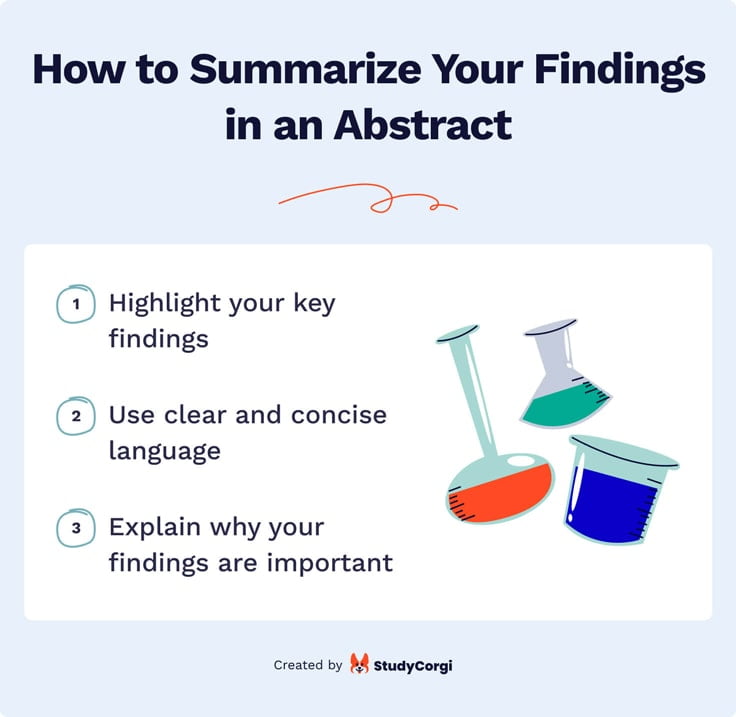
5. Conclude
The final step is to conclude your abstract. You can do it by addressing the significance of your findings and the role of your entire research. Note that you will need to write a summary for both types of abstracts, yet only the informative abstract will require you to discuss the effects of your work.
📝 Abstract Example for Free
We've prepared an example of a good abstract made with the help of our online generator. Feel free to use it to boost your inspiration.
Supplies and reserves affect the company's performance, so the choice of methods for controlling the inventory is a critical topic in modern management.
This research aims to study the possibilities of implementing the most effective inventory management system at the enterprise.
This work presents the results of quantitative and qualitative studies of the existing methods of inventory management. The data obtained made it possible to identify the advantages and disadvantages of various methods. Additionally, this research provides recommendations for using different inventory management systems, such as ERP and GSRP.
We hope that you've enjoyed our guide! To get an even better result, try our free abstract generator online. It will help you save time and enhance your academic writing skills. Good luck!
We also recommend using our conclusion generator and research question maker .
❓ AI Abstract Generator FAQ
❓ is there an abstract generator.
You can try out different apps on the internet, but our tool is definitely the best. StudyCorgi’s abstract generator is 100% free and unlimited. Besides, you can use it on any device. Try it out!
❓ How do I create an abstract online?
You can create an abstract using our abstract generator online. To do it, simply fill in all empty fields and press “Generate.” After creating your abstract, you can copy it and polish it however you like. This is how you make a perfect abstract online!
❓ Can AI write an abstract for me?
Our generator's AI can make an abstract for any subject or topic. It has a machine-learning system and can generate abstracts like a real human writer. You can use abstracts made by our app however you want—there are no copyright restrictions!
❓ Is 150 words good for an abstract?
The answer depends on the length of your research paper and the abstract type. For example, if you need to create a descriptive abstract, then 150 words is too lengthy. If your abstract is informative, then its length should be around 150-200 words.
Updated: Jun 5th, 2024
🔗 References
- Writing an Abstract for Your Research Paper: University of Wisconsin – Madison
- Writing an Abstract: The University of Melbourne
- Organizing Your Social Sciences Research Paper: The Abstract: University of Southern California
- Abstract Samples: Michigan State University
- Writing an Abstract: George Madison University
Instant Abstract Generator Tool
Generate compelling abstracts effortlessly for your research papers with our advanced AI-powered abstract generator.
2M+ Professionals choose us
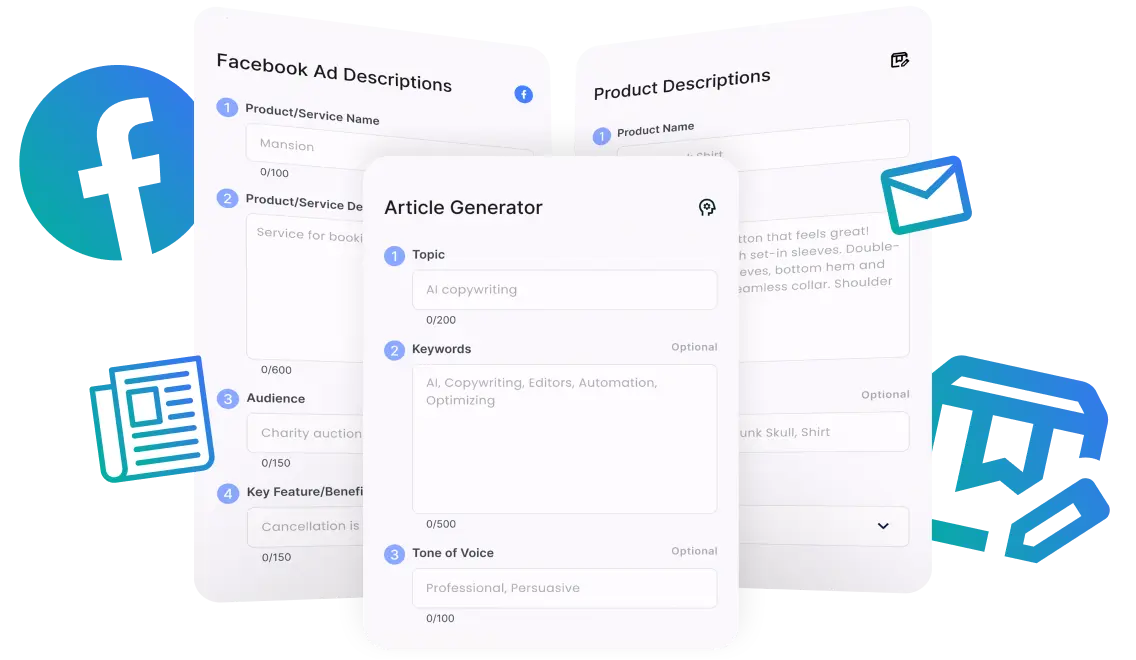
Maximize Your Research Impact
Enhanced research quality.
Elevate the quality of your research papers with concise and impactful abstracts to captivate readers.
Time-Saving Solution
Generate abstracts in seconds, saving valuable time for in-depth research and analysis.
Effortless Efficiency
Streamline the abstract creation process, allowing you to focus on the core aspects of your research.
Boost Your Research with Our Abstract Generator
Save time and effort.
Our abstract generator for research paper can save you valuable time and effort by creating a concise and comprehensive summary of your research. Instead of spending hours crafting an abstract, our tool can generate one for you within minutes.
With the ability to instantly produce a well-written abstract, you can allocate more time to conducting your research and refining your paper, ultimately enhancing the quality of your work.

Improve Visibility and Impact
By utilizing our abstract generator, you can improve the visibility and impact of your research paper. A well-crafted abstract can attract more readers and increase the chances of your paper being cited by other researchers.
With a captivating and informative abstract, you can effectively capture the attention of potential readers, leading to greater dissemination and recognition of your research findings.

Enhance Clarity and Coherence
Our abstract generator ensures that your research paper's abstract is clear, coherent, and effectively communicates the essence of your study. It helps in presenting a cohesive summary that accurately represents the key aspects of your research.
By enhancing the clarity and coherence of your abstract, you can effectively convey the significance and relevance of your research, making it more accessible to a wider audience.

Effective Strategies for Abstract Writing
Conciseness is key.
When writing an abstract, prioritize conciseness to ensure that only essential information is included. Avoid unnecessary details and focus on presenting a succinct summary of your research findings.
Conciseness not only captivates the reader's attention but also allows for a quick grasp of the paper's core content, making it more appealing to potential readers.
Emphasize Research Significance
Highlight the significance of your research in the abstract. Clearly articulate the problem addressed, the methodology used, and the key findings while emphasizing the broader implications of the study.
By emphasizing the significance of your research, you can attract the interest of readers who are seeking valuable and impactful contributions to the field.
Maintain Clarity and Precision
Ensure that your abstract maintains clarity and precision in its language and structure. Use clear and straightforward language to convey your research's core message while avoiding ambiguity and vagueness.
Clarity and precision in the abstract enable readers to quickly comprehend the research's purpose, methods, and outcomes, fostering a deeper understanding of the study.
Align with Journal Requirements
Adhere to the specific formatting and word limit requirements of the target journal when crafting your abstract. Ensure that the abstract fulfills the journal's guidelines to increase the likelihood of acceptance and publication.
Aligning with the journal's requirements demonstrates your attention to detail and professionalism, enhancing the overall presentation of your research paper.
Seek Feedback and Revision
Seek feedback on your abstract from peers, mentors, or colleagues to gain valuable insights and suggestions for improvement. Revision based on constructive feedback can significantly enhance the quality of the abstract.
Engaging in a feedback and revision process ensures that your abstract effectively captures the essence of your research while addressing any potential areas for enhancement.
Exploring the Abstract Generator
Discover the potential of our abstract generator through real-time examples. See how our tool can efficiently create compelling abstracts for your research papers.
Craft a concise abstract summarizing the key findings of a groundbreaking biology study.
Our innovative abstract generator swiftly creates a concise and impactful summary of the groundbreaking biology study's key findings. The abstract effectively encapsulates the study's methodology, significant discoveries, and broader implications, enticing readers to delve into the comprehensive research paper.
By utilizing our abstract generator, researchers in the field of biology can streamline the abstract writing process, ensuring that their studies receive the attention and recognition they deserve. With a clear and compelling abstract, the impact and visibility of the biology study are significantly amplified, contributing to its broader dissemination and influence within the scientific community.
The generated abstract succinctly communicates the study's significance and relevance, captivating the interest of readers and potential collaborators. It serves as a powerful tool for researchers to effectively convey the essence of their biology study, fostering engagement and discourse within the scientific domain.
With our abstract generator, crafting an engaging and informative abstract for the biology study becomes an efficient and seamless task, enabling researchers to allocate more time and effort to the advancement of their scientific inquiries. The tool's ability to produce a well-structured and coherent abstract enhances the overall presentation of the research, elevating its impact and contributing to the advancement of knowledge in the field of biology.
Experience the transformative capability of our abstract generator in conveying the essence of complex biology studies with precision and clarity. Elevate the visibility and recognition of your research through a meticulously crafted abstract that captures the essence of your biology study, resonating with the scientific community and beyond.
Unlock the potential of our abstract generator to elevate the impact and dissemination of biology research, facilitating seamless communication of key findings and insights. Empower your research endeavors with a compelling and concise abstract that effectively communicates the significance and contributions of your biology study, fostering engagement and recognition within the scientific landscape.
Generate an abstract outlining the key insights from a comprehensive environmental analysis report.
Our abstract generator swiftly produces a concise and impactful abstract that encapsulates the key insights from the comprehensive environmental analysis report. The abstract effectively communicates the report's findings, methodologies, and implications, offering readers a compelling overview of the in-depth analysis.
By leveraging our abstract generator, professionals in the environmental domain can streamline the abstract creation process, ensuring that their analysis reports garner the attention and interest they deserve. The generated abstract serves as a powerful introduction to the report, attracting readers and stakeholders to delve into the detailed analysis and findings, thereby enhancing the report's impact and reach.
The generated abstract succinctly captures the significance and relevance of the environmental analysis, providing a compelling synopsis that resonates with readers and decision-makers. It serves as a valuable tool for professionals to concisely convey the essence of their environmental analysis, fostering engagement and understanding within the relevant industry and beyond.
With our abstract generator, crafting an engaging and informative abstract for the environmental analysis report becomes an efficient and effective endeavor, enabling professionals to allocate more time and resources to furthering their environmental initiatives. The tool's ability to create a clear and coherent abstract enhances the overall presentation of the analysis, contributing to the dissemination of critical insights and fostering informed decision-making.
Experience the transformative potential of our abstract generator in succinctly communicating the essence of comprehensive environmental analyses. Elevate the visibility and impact of your environmental reports through a meticulously crafted abstract that captures the core insights, resonating with stakeholders, policymakers, and industry professionals.
Unlock the power of our abstract generator to enhance the accessibility and recognition of environmental analyses, facilitating the seamless communication of pivotal findings and recommendations. Empower your environmental endeavors with a compelling and concise abstract that effectively communicates the significance and implications of your analysis, fostering awareness and informed action within the environmental landscape.
Frequently Asked Questions
Can the abstract generator for research papers on justdone.ai create high-quality abstracts, does the abstract generator on justdone.ai support various research paper topics and disciplines, is the abstract generator on justdone.ai user-friendly and easy to use, can the abstract generator on justdone.ai help in meeting the word limit requirements for abstracts, does the abstract generator on justdone.ai offer customizable options for creating abstracts, is the abstract generator on justdone.ai capable of enhancing the readability and coherence of abstracts, join 1,000,000+ creators and professionals from trusted companies by choosing us, .css-hlqu4j{margin:0;font-family:"roboto","helvetica","arial",sans-serif;font-weight:400;font-size:1rem;line-height:1.5;letter-spacing:0.00938em;max-width:700px;}@media (min-width:0px){.css-hlqu4j{font-size:24px;font-weight:600;line-height:32px;font-family:'__inter_24c5c3','__inter_fallback_24c5c3';}}@media (min-width:744px){.css-hlqu4j{font-size:45px;font-weight:600;line-height:52px;font-family:'__inter_24c5c3','__inter_fallback_24c5c3';}} have a task that has no tool our chat knows how to do it.
Abstract Generator
AI Abstract Generator
Our AI Abstract Generator is a versatile tool that simplifies the process of creating abstracts. It adheres to APA guidelines and ensures accurate and unbiased abstracts. Powered by advanced AI technology, it generates abstracts quickly.
The tool is easy to use, with a user-friendly interface that requires no technical expertise. It’s a free abstract generator that can handle a variety of styles, including the APA format. Whether you're a student, teacher, or employee, our abstract generator is a valuable resource for creating high-quality abstracts.
Features of our AI Abstract Generator tool
Unbiased abstracts.
Our tool ensures the creation of unbiased abstracts for your research papers, documents, and articles. It makes your assignments less time-consuming.
Advanced AI technology
Our AI-powered free abstract generator APA utilizes advanced algorithms to summarize your content accurately. This AI abstract generator writes error-free abstract based on your content.
Ease and convenience
Our abstract creator offers a user-friendly interface, making it simple and intuitive to generate high-quality abstracts.
100% free service
Our AI abstract generator comes without any cost limitations. The free abstract generator enables you to seek assistance with professional quality abstract for your work.
Working of our APA AI Abstract Generator tool
The AI abstract generator is a free tool that saves time and effort by creating accurate, APA-compliant abstracts. It streamlines the writing process by utilizing the AI Abstract Generator model, which automatically generates an abstract based on content summary. This convenient and reliable solution is perfect for students and researchers, allowing them to streamline their abstract writing process.
To use our AI Abstract Generator APA, follow the steps below:
Copy and paste the content into the input box.
Click the "generate abstract" button to initiate the abstract generation process., wait for the tool to analyze and process the abstracts for the content., once the abstract is generated, it will be displayed on the screen., review the generated abstract and make any necessary adjustments or edits., once reviewed, download or export the results..
| ⚡ Advance AI Technology | Quickly Creates Abstracts | |
😍 Unbiased Summary | Avoid Personal Biases | |
👨🏼🎓 Users | Academic, Writers & Professionals | |
💰 100% Free | No Sign Up Required |
Users of our AI Abstract Generator tool
Our tool caters to a wide range of users. Students can benefit from the tool to create abstracts for their research papers, assignments, and dissertations.
Teachers can use our abstract generator online free tool to guide students in writing effective abstracts. They can also use it for their own research projects.
If you’re an employee, you can utilize this tool for business reports and presentations. The AI Abstract Generator allows you to save a lot of time.
Freelancers
Freelancers can enhance their portfolio by generating compelling abstracts using the advanced and efficiently-designed free abstract generator. It can also be helpful for working on a client's academic projects.
Copywriters can create engaging abstracts for marketing materials. Use the online abstract generator for free of charge to help generate high-quality objectives and summaries for your articles and blogs.
News editors
News editors can use this tool to summarize news articles effectively, or to get the gist of lengthy documents to save time and effort when researching.
Explore our suite of AI writing tools for paraphrasing, grammar checking, summarzing and much more!
What are the 5 important parts of abstract writing.
The five important parts of abstract writing include a concise summary of the research topic, the research objectives or questions, the methodology employed, key findings or results, and the significance or implications of the study. These components make an abstract complete.
What is the ideal length of an abstract?
The ideal length of an abstract can vary depending on the specific requirements of the publication or academic institution. However, in general, abstracts are around 150 to 250 words in length, providing a concise summary of the research study.
Which other tools does Paraphrasing-Tool have?
Our Paraphrasing-tool offers a range of writing and editing tools, including paraphrasing , summarizing , grammar checking , and more. These tools provide comprehensive support for all your writing needs.
Copyright © 2024 Paraphrasing-tool.com. All rights reserved.
Have a language expert improve your writing
Run a free plagiarism check in 10 minutes, generate accurate citations for free.
- Knowledge Base
- Dissertation
- How to Write an Abstract | Steps & Examples
How to Write an Abstract | Steps & Examples
Published on February 28, 2019 by Shona McCombes . Revised on July 18, 2023 by Eoghan Ryan.

An abstract is a short summary of a longer work (such as a thesis , dissertation or research paper ). The abstract concisely reports the aims and outcomes of your research, so that readers know exactly what your paper is about.
Although the structure may vary slightly depending on your discipline, your abstract should describe the purpose of your work, the methods you’ve used, and the conclusions you’ve drawn.
One common way to structure your abstract is to use the IMRaD structure. This stands for:
- Introduction
Abstracts are usually around 100–300 words, but there’s often a strict word limit, so make sure to check the relevant requirements.
In a dissertation or thesis , include the abstract on a separate page, after the title page and acknowledgements but before the table of contents .
Instantly correct all language mistakes in your text
Upload your document to correct all your mistakes in minutes

Table of contents
Abstract example, when to write an abstract, step 1: introduction, step 2: methods, step 3: results, step 4: discussion, tips for writing an abstract, other interesting articles, frequently asked questions about abstracts.
Hover over the different parts of the abstract to see how it is constructed.
This paper examines the role of silent movies as a mode of shared experience in the US during the early twentieth century. At this time, high immigration rates resulted in a significant percentage of non-English-speaking citizens. These immigrants faced numerous economic and social obstacles, including exclusion from public entertainment and modes of discourse (newspapers, theater, radio).
Incorporating evidence from reviews, personal correspondence, and diaries, this study demonstrates that silent films were an affordable and inclusive source of entertainment. It argues for the accessible economic and representational nature of early cinema. These concerns are particularly evident in the low price of admission and in the democratic nature of the actors’ exaggerated gestures, which allowed the plots and action to be easily grasped by a diverse audience despite language barriers.
Keywords: silent movies, immigration, public discourse, entertainment, early cinema, language barriers.
Receive feedback on language, structure, and formatting
Professional editors proofread and edit your paper by focusing on:
- Academic style
- Vague sentences
- Style consistency
See an example

You will almost always have to include an abstract when:
- Completing a thesis or dissertation
- Submitting a research paper to an academic journal
- Writing a book or research proposal
- Applying for research grants
It’s easiest to write your abstract last, right before the proofreading stage, because it’s a summary of the work you’ve already done. Your abstract should:
- Be a self-contained text, not an excerpt from your paper
- Be fully understandable on its own
- Reflect the structure of your larger work
Start by clearly defining the purpose of your research. What practical or theoretical problem does the research respond to, or what research question did you aim to answer?
You can include some brief context on the social or academic relevance of your dissertation topic , but don’t go into detailed background information. If your abstract uses specialized terms that would be unfamiliar to the average academic reader or that have various different meanings, give a concise definition.
After identifying the problem, state the objective of your research. Use verbs like “investigate,” “test,” “analyze,” or “evaluate” to describe exactly what you set out to do.
This part of the abstract can be written in the present or past simple tense but should never refer to the future, as the research is already complete.
- This study will investigate the relationship between coffee consumption and productivity.
- This study investigates the relationship between coffee consumption and productivity.
Next, indicate the research methods that you used to answer your question. This part should be a straightforward description of what you did in one or two sentences. It is usually written in the past simple tense, as it refers to completed actions.
- Structured interviews will be conducted with 25 participants.
- Structured interviews were conducted with 25 participants.
Don’t evaluate validity or obstacles here — the goal is not to give an account of the methodology’s strengths and weaknesses, but to give the reader a quick insight into the overall approach and procedures you used.
Next, summarize the main research results . This part of the abstract can be in the present or past simple tense.
- Our analysis has shown a strong correlation between coffee consumption and productivity.
- Our analysis shows a strong correlation between coffee consumption and productivity.
- Our analysis showed a strong correlation between coffee consumption and productivity.
Depending on how long and complex your research is, you may not be able to include all results here. Try to highlight only the most important findings that will allow the reader to understand your conclusions.
Finally, you should discuss the main conclusions of your research : what is your answer to the problem or question? The reader should finish with a clear understanding of the central point that your research has proved or argued. Conclusions are usually written in the present simple tense.
- We concluded that coffee consumption increases productivity.
- We conclude that coffee consumption increases productivity.
If there are important limitations to your research (for example, related to your sample size or methods), you should mention them briefly in the abstract. This allows the reader to accurately assess the credibility and generalizability of your research.
If your aim was to solve a practical problem, your discussion might include recommendations for implementation. If relevant, you can briefly make suggestions for further research.
If your paper will be published, you might have to add a list of keywords at the end of the abstract. These keywords should reference the most important elements of the research to help potential readers find your paper during their own literature searches.
Be aware that some publication manuals, such as APA Style , have specific formatting requirements for these keywords.
It can be a real challenge to condense your whole work into just a couple of hundred words, but the abstract will be the first (and sometimes only) part that people read, so it’s important to get it right. These strategies can help you get started.
Read other abstracts
The best way to learn the conventions of writing an abstract in your discipline is to read other people’s. You probably already read lots of journal article abstracts while conducting your literature review —try using them as a framework for structure and style.
You can also find lots of dissertation abstract examples in thesis and dissertation databases .
Reverse outline
Not all abstracts will contain precisely the same elements. For longer works, you can write your abstract through a process of reverse outlining.
For each chapter or section, list keywords and draft one to two sentences that summarize the central point or argument. This will give you a framework of your abstract’s structure. Next, revise the sentences to make connections and show how the argument develops.
Write clearly and concisely
A good abstract is short but impactful, so make sure every word counts. Each sentence should clearly communicate one main point.
To keep your abstract or summary short and clear:
- Avoid passive sentences: Passive constructions are often unnecessarily long. You can easily make them shorter and clearer by using the active voice.
- Avoid long sentences: Substitute longer expressions for concise expressions or single words (e.g., “In order to” for “To”).
- Avoid obscure jargon: The abstract should be understandable to readers who are not familiar with your topic.
- Avoid repetition and filler words: Replace nouns with pronouns when possible and eliminate unnecessary words.
- Avoid detailed descriptions: An abstract is not expected to provide detailed definitions, background information, or discussions of other scholars’ work. Instead, include this information in the body of your thesis or paper.
If you’re struggling to edit down to the required length, you can get help from expert editors with Scribbr’s professional proofreading services or use the paraphrasing tool .
Check your formatting
If you are writing a thesis or dissertation or submitting to a journal, there are often specific formatting requirements for the abstract—make sure to check the guidelines and format your work correctly. For APA research papers you can follow the APA abstract format .
Checklist: Abstract
The word count is within the required length, or a maximum of one page.
The abstract appears after the title page and acknowledgements and before the table of contents .
I have clearly stated my research problem and objectives.
I have briefly described my methodology .
I have summarized the most important results .
I have stated my main conclusions .
I have mentioned any important limitations and recommendations.
The abstract can be understood by someone without prior knowledge of the topic.
You've written a great abstract! Use the other checklists to continue improving your thesis or dissertation.
If you want to know more about AI for academic writing, AI tools, or research bias, make sure to check out some of our other articles with explanations and examples or go directly to our tools!
Research bias
- Anchoring bias
- Halo effect
- The Baader–Meinhof phenomenon
- The placebo effect
- Nonresponse bias
- Deep learning
- Generative AI
- Machine learning
- Reinforcement learning
- Supervised vs. unsupervised learning
(AI) Tools
- Grammar Checker
- Paraphrasing Tool
- Text Summarizer
- AI Detector
- Plagiarism Checker
- Citation Generator
An abstract is a concise summary of an academic text (such as a journal article or dissertation ). It serves two main purposes:
- To help potential readers determine the relevance of your paper for their own research.
- To communicate your key findings to those who don’t have time to read the whole paper.
Abstracts are often indexed along with keywords on academic databases, so they make your work more easily findable. Since the abstract is the first thing any reader sees, it’s important that it clearly and accurately summarizes the contents of your paper.
An abstract for a thesis or dissertation is usually around 200–300 words. There’s often a strict word limit, so make sure to check your university’s requirements.
The abstract is the very last thing you write. You should only write it after your research is complete, so that you can accurately summarize the entirety of your thesis , dissertation or research paper .
Avoid citing sources in your abstract . There are two reasons for this:
- The abstract should focus on your original research, not on the work of others.
- The abstract should be self-contained and fully understandable without reference to other sources.
There are some circumstances where you might need to mention other sources in an abstract: for example, if your research responds directly to another study or focuses on the work of a single theorist. In general, though, don’t include citations unless absolutely necessary.
The abstract appears on its own page in the thesis or dissertation , after the title page and acknowledgements but before the table of contents .
Cite this Scribbr article
If you want to cite this source, you can copy and paste the citation or click the “Cite this Scribbr article” button to automatically add the citation to our free Citation Generator.
McCombes, S. (2023, July 18). How to Write an Abstract | Steps & Examples. Scribbr. Retrieved July 10, 2024, from https://www.scribbr.com/dissertation/abstract/
Is this article helpful?
Shona McCombes
Other students also liked, how to write a thesis or dissertation introduction, shorten your abstract or summary, how to write a literature review | guide, examples, & templates, what is your plagiarism score.
The Writing Planet

50 % off on all orders
Research Paper Abstract Generator
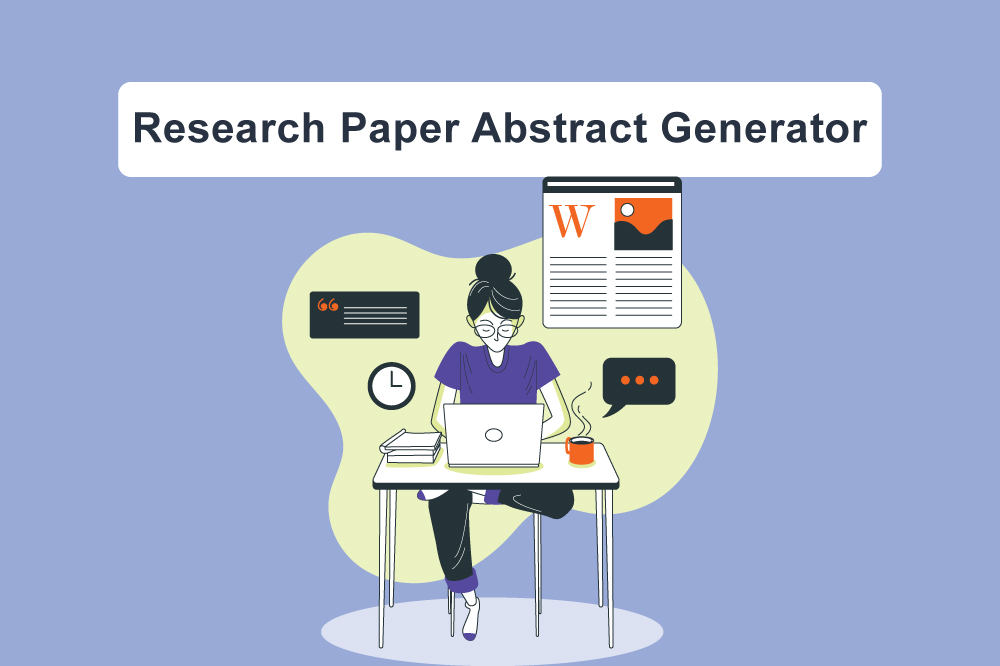
The abstract of a research paper provides a key summary of your paper. They give the reader a summary of your paper; however, the majority of individuals are terrified of writing this essential section.
Why? It may determine the success or failure of a paper.
Would you like to present at a conference? You must include an abstract with your application, and it must pique the reviewers’ interest. When you submit your paper for grading or present the field in which you worked with your most recent study, your abstract must be as strong as possible.
Although it may appear scary, especially if this is your first time, we have provided you with information on what abstracts are and basic instructions on how to write abstracts for a variety of scenarios.
What Is a Research Paper Abstract Generator?
Using superior AI technology, the abstract generator enables you to compose an abstract for your research paper. The free abstract generator generates a title and precise description of the material given with a single click. The research paper abstract generator generates an acceptable research paper abstract by including the most pertinent and essential phrases from the paper’s body.
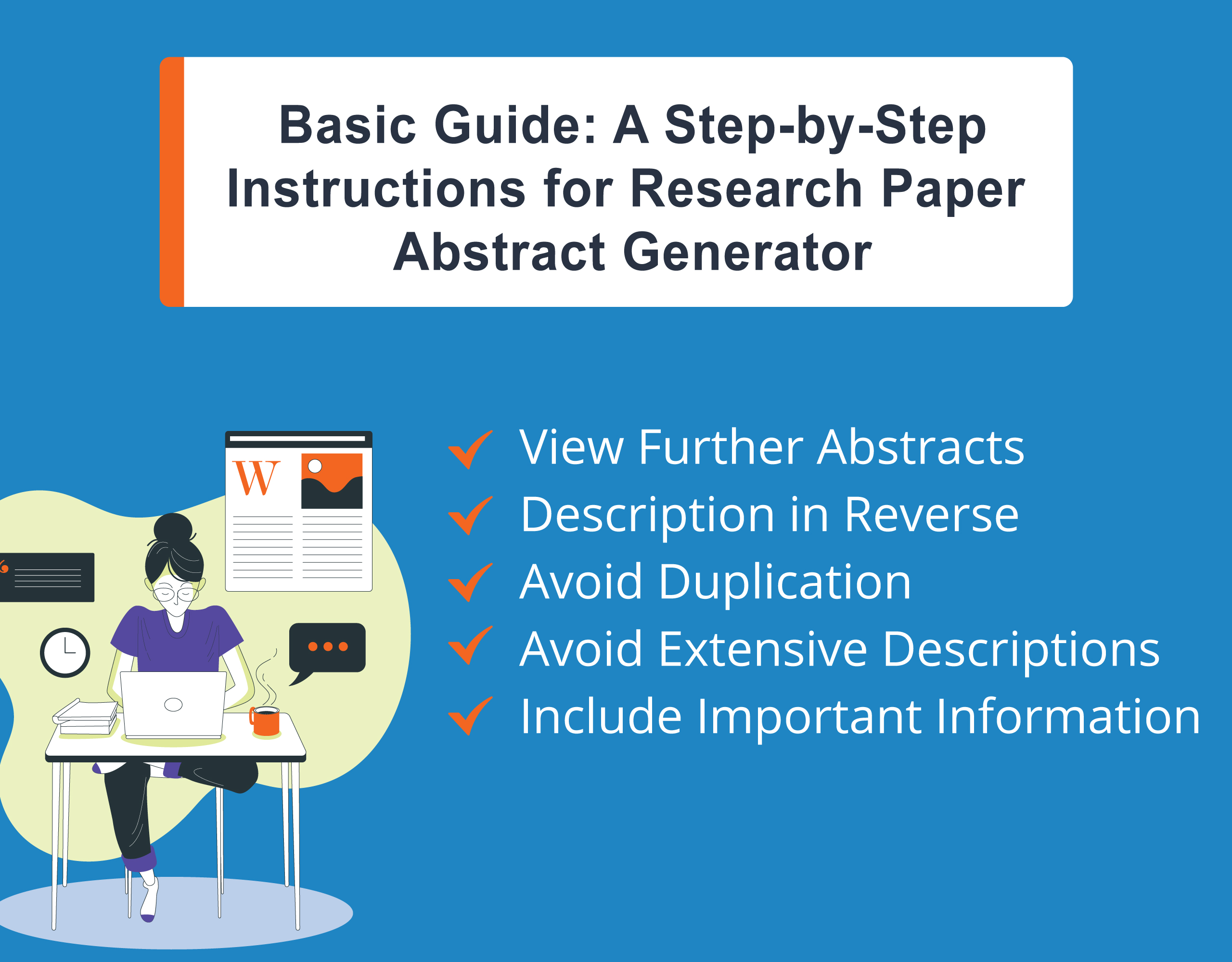
What Is An Abstract?
Let’s define an abstract prior to entering the abstract domain.
An abstract is a succinct and unambiguous overview that comprises your hypothesis, the context of your study, a sentence or two describing your methodology, and your conclusion. It provides viewers with a preview of your work and helps them decide whether to read it. Consider it a more in-depth book summary or movie trailer! Including all of this essential information enables others to acquire the knowledge they need for their professions fast. Importantly, your abstract should be concise; you should aim for between 100 and 500 words. Aim for around 300 words for an exact word count.
Your abstract is not an expansion or evaluation of your research work, nor is it a criticism or suggestion. Its purpose is to explain your article. When submitting your work for evaluation, publishing, submission to a regulatory body, or permission to speak at a conference, you are typically expected to produce an abstract. Consequently, your abstract must contain a great deal of information. Refrain from believing that a single notion will suffice in all of these circumstances.
Writing an Abstract
You may be tempted to write your abstract first because it will be the first section of your paper, but it’s better to wait until you’ve done your entire project so you know exactly what you’re summarizing. If you are writing an abstract for a course paper, your professor may provide you with precise guidelines on its content and structure. Similarly, scientific publications often adhere to stringent abstract standards. In addition to following the directions on this page, you should look for and adhere to any rules from the course or publication for which you are writing.
The Structure of a Research Paper
Willing to examine scientific publications, evaluate several studies, and even learn how a research paper summary tool operates? In this case, you will be inquisitive about the structure of such academic papers. Here, we have just described the normal format of scholarly papers.
Include the following sections in your research paper:
The abstract of a research paper provides a summary of the research project. It emphasizes the premise and noteworthy findings. Your audience will utilize it to comprehend the overall concept and purpose of the study rapidly. Utilize our online summary generator for this section. Abstracts in scientific works are often one paragraph at maximum.
Introduction
In the beginning, you should situate your study subject. Describe the subject and include any pertinent earlier research. Additionally, this is where you would typically outline a knowledge gap you wish to address. Explain why the topic you are addressing is significant and requires more examination.
Methodology
In this part, you must describe the study’s methodology. Describe how the research was conducted and who was involved. Describe your methodology as well as the materials and technologies employed. You must also outline the data collecting and analysis procedures. It is essential to remember that someone else should be able to duplicate your study using these ideas.
In the results portion of your research report, you will provide the collected data. You must also include the findings of any statistical tests you conduct. Keep in mind the main research questions throughout this strategy. In this area, you should relate your findings to it.
Explain the relevance of your methodology and results once you have completed your report. Discuss the consequences of the most significant components of your study. Consider your topic and your objectives for the research. Discuss its flaws and how they can be addressed in the future.
The final portion of your work is a bibliography also known as references. It is a list of the sources you consulted for your paper. It should be formatted according to your school’s specifications. Ensure that things are organized alphabetically.
Instructions for Writing an Abstract
It may take a great deal of effort to condense your whole work into a few hundred words, but the research paper abstract will be the first (and often only) item that people read, so it is crucial that it be written correctly. These tips can help you get started.
View Further Abstracts
Reading the abstracts of others is the best approach to learning how to write an abstract on your topic. Consider utilizing journal article abstracts as a model for organization and style, as you have likely read hundreds of them while performing your research review. Thesis and dissertation databases also provide hundreds of samples of dissertation abstracts.
Description in Reverse
Not all abstractions will include identical components. For lengthier works, write your abstract in reverse outline format. Each chapter or section should include a list of keywords and a one- to a two-line summary of the major point or argument. This will serve as a guide for the organization of your abstract. Then, modify the phrases to establish connections and illustrate how the argument develops.
Write Effectively and Concisely
An effective abstract is concise and persuasive, so ensure that every word counts. Each sentence should elaborate on a significant point.
Passive Expressions Must Be Avoided
Frequently, passive construction should be shorter. Employ the active voice to make them shorter and more comprehensible.
Avoid Using Obscure Jargon
The abstract should be understandable to those unfamiliar with the subject matter.
Avoid Duplication and Filler
Replace nouns with pronouns wherever feasible and avoid using unneeded words.
Avoid Extensive Descriptions
The purpose of an abstract is not to provide detailed definitions, context, or commentary on the work of other scholars. Instead, provide this material in the body of your dissertation or paper.
Investigate Your Formatting
If you are writing a thesis or dissertation or submitting to a publication, the abstract must be structured exactly; be sure to adhere to the instructions and prepare your work accordingly. APA research papers may utilize the APA abstract format.
Only Copy Complete Phrases from Papers
In theory, it may appear to be a great strategy, but in practice, it will just bring you headaches. You will need more than just using terminology from your work to write a clear, accurate, and succinct abstract. This will prevent your abstract from becoming an actual abstract and will likely make it illogical.
Include Important Information
You must include the required information in your abstract to be accepted.
Avoid Adding Too Many Details
To qualify the preceding point, it is also a major no-no to provide too much information in your abstract. Finding the optimal balance might be challenging; thus, your abstract should be clear and transparent. Remove unnecessary phrases and terms that “fluff up” your research.
Your Abstract Is What Piques the Reader’s Curiosity
Unfortunately, they only have time to read your entire paper, especially in the case of conference submissions. The readers want to know if your work will aid them with their study or if it is the appropriate piece for their conference.
What Makes A Bad Abstract?
Not following abstract structure directions.
If you have been informed of the structure and format that the institution to which you are submitting your abstract requires, adhere to it precisely. Remember to include everything, and do not assume that if you miss one small detail, it will not matter because it will!
Omission to Include Important Keywords
In order for your abstract/paper to be effectively indexed and easily discoverable, you must include keywords.
Not Offering an Exhaustive Overview
You must provide a brief description of each section of your work. You’ve included the results, but if you have an introduction, method, outcomes/results, and analysis/discussion, you must summarize them all in your abstract.
Online Services for Abstract Writing
Researchers devoted a number of hours to ensuring that their investigation was conducted thoroughly and precisely that all approaches and new discoveries were examined, and that every minute observation was recorded.
So, when it’s time to publish your work, how can you condense your research into a concise essay that satisfies the Journal’s stringent requirements without sacrificing essential information?
You have access to a number of online abstract writing services . These services will condense your whole material without compromising vital details or the effectiveness of your work. These online writing services will also ensure that the content flows logically and is accessible to a wide variety of readers. Your abstract will also contain potent keywords that will increase your database search results.
Research paper abstracts are an excellent way for summarizing your study for your audience. It describes the nature of the inquiry, the methodology employed, and the results. Consider refining your academic writing abilities in order to excel in your abstract. In addition, despite the fact that writing an abstract may first look tough, if you follow the guidelines provided above, you should find the process easier and more fun.
Frequently Asked Questions
How to write a good research paper abstract.
An abstract should be able to be understood without reading the full article or consulting any other resources. It emphasizes important subject areas, the purpose of your research, the relevance of your work, and the primary conclusions.
How do I start an abstract research paper?
The abstract should begin with a brief yet precise statement of the problem or topic, followed by a discussion of the research methods and methodology, the noteworthy results, and the conclusions reached.
Previous Posts
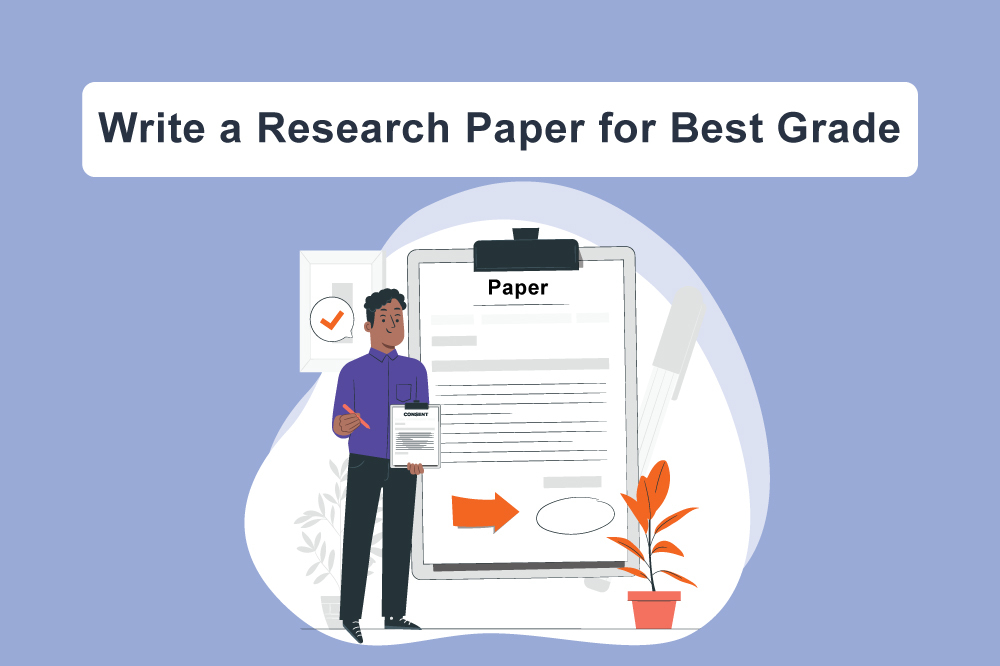
Write My Research Paper for Me to get an ‘A ‘ grade?

Research Paper Help – Professional Writing Assistance

What Is The Difference Between Research Paper and Essay

Get science-backed answers as you write with Paperpal's Research feature
How to Write an Abstract in Research Papers (with Examples)

An abstract in research papers is a keyword-rich summary usually not exceeding 200-350 words. It can be considered the “face” of research papers because it creates an initial impression on the readers. While searching databases (such as PubMed) for research papers, a title is usually the first selection criterion for readers. If the title matches their search criteria, then the readers read the abstract, which sets the tone of the paper. Titles and abstracts are often the only freely available parts of research papers on journal websites. The pdf versions of full articles need to be purchased. Journal reviewers are often provided with only the title and abstract before they agree to review the complete paper. [ 1]
Abstracts in research papers provide readers with a quick insight into what the paper is about to help them decide whether they want to read it further or not. Abstracts are the main selling points of articles and therefore should be carefully drafted, accurately highlighting the important aspects. [ 2]
This article will help you identify the important components and provide tips on how to write an abstract in research papers effectively
What is an Abstract?
An abstract in research papers can be defined as a synopsis of the paper. It should be clear, direct, self-contained, specific, unbiased, and concise. These summaries are published along with the complete research paper and are also submitted to conferences for consideration for presentation.
Abstracts are of four types and journals can follow any of these formats: [ 2]
- Structured
- Unstructured
- Descriptive
- Informative
Structured abstracts are used by most journals because they are more organized and have clear sections, usually including introduction/background; objective; design, settings, and participants (or materials and methods); outcomes and measures; results; and conclusion. These headings may differ based on the journal or the type of paper. Clinical trial abstracts should include the essential items mentioned in the CONSORT (Consolidated Standards Of Reporting Trials) guidelines.

Figure 1. Structured abstract example [3]
Unstructured abstracts are common in social science, humanities, and physical science journals. They usually have one paragraph and no specific structure or subheadings. These abstracts are commonly used for research papers that don’t report original work and therefore have a more flexible and narrative style.

Figure 2. Unstructured abstract example [3]
Descriptive abstracts are short (75–150 words) and provide an outline with only the most important points of research papers. They are used for shorter articles such as case reports, reviews, and opinions where space is at a premium, and rarely for original investigations. These abstracts don’t present the results but mainly list the topics covered.
Here’s a sample abstract . [ 4]
“Design of a Radio-Based System for Distribution Automation”
A new survey by the Maryland Public Utilities Commission suggests that utilities have not effectively explained to consumers the benefits of smart meters. The two-year study of 86,000 consumers concludes that the long-term benefits of smart meters will not be realized until consumers understand the benefits of shifting some of their power usage to off-peak hours in response to the data they receive from their meters. The study presents recommendations for utilities and municipal governments to improve customer understanding of how to use the smart meters effectively.
Keywords: smart meters, distribution systems, load, customer attitudes, power consumption, utilities
Informative abstracts (structured or unstructured) give a complete detailed summary, including the main results, of the research paper and may or may not have subsections.

Figure 3. Informative abstract example [5]
Purpose of Abstracts in Research
Abstracts in research have two main purposes—selection and indexing. [ 6,7]
- Selection : Abstracts allow interested readers to quickly decide the relevance of a paper to gauge if they should read it completely.
- Indexing : Most academic journal databases accessed through libraries enable you to search abstracts, allowing for quick retrieval of relevant articles and avoiding unnecessary search results. Therefore, abstracts must necessarily include the keywords that researchers may use to search for articles.
Thus, a well-written, keyword-rich abstract can p ique readers’ interest and curiosity and help them decide whether they want to read the complete paper. It can also direct readers to articles of potential clinical and research interest during an online search.

Contents of Abstracts in Research
Abstracts in research papers summarize the main points of an article and are broadly categorized into four or five sections. Here are some details on how to write an abstract .
Introduction/Background and/or Objectives
This section should provide the following information:
- What is already known about the subject?
- What is not known about the subject or what does the study aim to investigate?
The hypothesis or research question and objectives should be mentioned here. The Background sets the context for the rest of the paper and its length should be short so that the word count could be saved for the Results or other information directly pertaining to the study. The objective should be written in present or past simple tense.
Examples:
The antidepressant efficacy of desvenlafaxine (DV) has been established in 8-week, randomized controlled trials. The present study examined the continued efficacy of DV across 6 months of maintenance treatment . [ 1]
Objective: To describe gastric and breast cancer risk estimates for individuals with CDH1 variants.
Design, Setting, and Participants (or Materials and Methods)
This section should provide information on the processes used and should be written in past simple tense because the process is already completed.
A few important questions to be answered include:
- What was the research design and setting?
- What was the sample size and how were the participants sampled?
- What treatments did the participants receive?
- What were the data collection and data analysis dates?
- What was the primary outcome measure?
Hazard ratios (HRs) were estimated for each cancer type and used to calculate cumulative risks and risks per decade of life up to age 80 years.

This section, written in either present or past simple tense, should be the longest and should describe the main findings of the study. Here’s an example of how descriptive the sentences should be:
Avoid: Response rates differed significantly between diabetic and nondiabetic patients.
Better: The response rate was higher in nondiabetic than in diabetic patients (49% vs 30%, respectively; P<0.01).
This section should include the following information:
- Total number of patients (included, excluded [exclusion criteria])
- Primary and secondary outcomes, expressed in words, and supported by numerical data
- Data on adverse outcomes
Example: [ 8]
In total, 10.9% of students were reported to have favorable study skills. The minimum score was found for preparation for examination domain. Also, a significantly positive correlation was observed between students’ study skills and their Grade Point Average (GPA) of previous term (P=0.001, r=0.269) and satisfaction with study skills (P=0.001, r=0.493).
Conclusions
Here, authors should mention the importance of their findings and also the practical and theoretical implications, which would benefit readers referring to this paper for their own research. Present simple tense should be used here.
Examples: [ 1,8]
The 9.3% prevalence of bipolar spectrum disorders in students at an arts university is substantially higher than general population estimates. These findings strengthen the oft-expressed hypothesis linking creativity with affective psychopathology.
The findings indicated that students’ study skills need to be improved. Given the significant relationship between study skills and GPA, as an index of academic achievement, and satisfaction, it is necessary to promote the students’ study skills. These skills are suggested to be reinforced, with more emphasis on weaker domains.

When to Write an Abstract
In addition to knowing how to write an abstract , you should also know when to write an abstract . It’s best to write abstracts once the paper is completed because this would make it easier for authors to extract relevant parts from every section.
Abstracts are usually required for: [ 7]
- submitting articles to journals
- applying for research grants
- writing book proposals
- completing and submitting dissertations
- submitting proposals for conference papers
Mostly, the author of the entire work writes the abstract (the first author, in works with multiple authors). However, there are professional abstracting services that hire writers to draft abstracts of other people’s work.
How to Write an Abstract (Step-by-Step Process)
Here are some key steps on how to write an abstract in research papers: [ 9]
- Write the abstract after you’ve finished writing your paper.
- Select the major objectives/hypotheses and conclusions from your Introduction and Conclusion sections.
- Select key sentences from your Methods section.
- Identify the major results from the Results section.
- Paraphrase or re-write the sentences selected in steps 2, 3, and 4 in your own words into one or two paragraphs in the following sequence: Introduction/Objective, Methods, Results, and Conclusions. The headings may differ among journals, but the content remains the same.
- Ensure that this draft does not contain: a. new information that is not present in the paper b. undefined abbreviations c. a discussion of previous literature or reference citations d. unnecessary details about the methods used
- Remove all extra information and connect your sentences to ensure that the information flows well, preferably in the following order: purpose; basic study design, methodology and techniques used; major findings; summary of your interpretations, conclusions, and implications. Use section headings for structured abstracts.
- Ensure consistency between the information presented in the abstract and the paper.
- Check to see if the final abstract meets the guidelines of the target journal (word limit, type of abstract, recommended subheadings, etc.) and if all the required information has been included.
Choosing Keywords for Abstracts
Keywords [ 2] are the important and repeatedly used words and phrases in research papers and can help indexers and search engines find papers relevant to your requirements. Easy retrieval would help in reaching a wider audience and eventually gain more citations. In the fields of medicine and health, keywords should preferably be chosen from the Medical Subject Headings (MeSH) list of the US National Library of Medicine because they are used for indexing. These keywords need to be different from the words in the main title (automatically used for indexing) but can be variants of the terms/phrases used in the title, abstract, and the main text. Keywords should represent the content of your manuscript and be specific to your subject area.
Basic tips for authors [ 10,11]
- Read through your paper and highlight key terms or phrases that are most relevant and frequently used in your field, to ensure familiarity.
- Several journals provide instructions about the length (eg, 3 words in a keyword) and maximum number of keywords allowed and other related rules. Create a list of keywords based on these instructions and include specific phrases containing 2 to 4 words. A longer string of words would yield generic results irrelevant to your field.
- Use abbreviations, acronyms, and initializations if these would be more familiar.
- Search with your keywords to ensure the results fit with your article and assess how helpful they would be to readers.
- Narrow down your keywords to about five to ten, to ensure accuracy.
- Finalize your list based on the maximum number allowed.
Few examples: [ 12]
| Direct observation of nonlinear optics in an isolated carbon nanotube | molecule, optics, lasers, energy lifetime | single-molecule interaction, Kerr effect, carbon nanotube, energy level |
| Region-specific neuronal degeneration after okadaic acid administration | neuron, brain, regional-specific neuronal degeneration, signaling | neurodegenerative diseases; CA1 region, hippocampal; okadaic acid; neurotoxins; MAP kinase signaling system; cell death |
| Increases in levels of sediment transport at former glacial-interglacial transitions | climate change, erosion, plant effects | quaternary climate change, soil erosion, bioturbation |
Important Tips for Writing an Abstract
Here are a few tips on how to write an abstract to ensure that your abstract is complete, concise, and accurate. [ 1,2]
- Write the abstract last.
- Follow journal-specific formatting guidelines or Instructions to Authors strictly to ensure acceptance for publication.
- Proofread the final draft meticulously to avoid grammatical or typographical errors.
- Ensure that the terms or data mentioned in the abstract are consistent with the main text.
- Include appropriate keywords at the end.
Do not include:
- New information
- Text citations to references
- Citations to tables and figures
- Generic statements
- Abbreviations unless necessary, like a trial or study name

Key Takeaways
Here’s a quick snapshot of all the important aspects of how to write an abstract . [2]
- An abstract in research is a summary of the paper and describes only the main aspects. Typically, abstracts are about 200-350 words long.
- Abstracts are of four types—structured, unstructured, descriptive, and informative.
- Abstracts should be simple, clear, concise, independent, and unbiased (present both favorable and adverse outcomes).
- They should adhere to the prescribed journal format, including word limits, section headings, number of keywords, fonts used, etc.
- The terminology should be consistent with the main text.
- Although the section heading names may differ for journals, every abstract should include a background and objective, analysis methods, primary results, and conclusions.
- Nonstandard abbreviations, references, and URLs shouldn’t be included.
- Only relevant and specific keywords should be used to ensure focused searches and higher citation frequency.
- Abstracts should be written last after completing the main paper.
Frequently Asked Questions
Q1. Do all journals have different guidelines for abstracts?
A1. Yes, all journals have their own specific guidelines for writing abstracts; a few examples are given in the following table. [ 6,13,14,15]
| American Psychological Association | |
| American Society for Microbiology | |
| The Lancet | |
| Journal of the American Medical Association |
Q2. What are the common mistakes to avoid when writing an abstract?
A2. Listed below are a few mistakes that authors may make inadvertently while writing abstracts.
- Copying sentences from the paper verbatim
An abstract is a summary, which should be created by paraphrasing your own work or writing in your own words. Extracting sentences from every section and combining them into one paragraph cannot be considered summarizing.
- Not adhering to the formatting guidelines
Journals have special instructions for writing abstracts, such as word limits and section headings. These should be followed strictly to avoid rejections.
- Not including the right amount of details in every section
Both too little and too much information could discourage readers. For instance, if the Background has very little information, the readers may not get sufficient context to appreciate your research. Similarly, incomplete information in the Methods and a text-heavy Results section without supporting numerical data may affect the credibility of your research.
- Including citations, standard abbreviations, and detailed measurements
Typically, abstracts shouldn’t include these elements—citations, URLs, and abbreviations. Only nonstandard abbreviations are allowed or those that would be more familiar to readers than the expansions.
- Including new information
Abstracts should strictly include only the same information mentioned in the main text. Any new information should first be added to the text and then to the abstract only if necessary or if permitted by the word limit.
- Not including keywords
Keywords are essential for indexing and searching and should be included to increase the frequency of retrieval and citation.
Q3. What is the difference between abstracts in research papers and conference abstracts? [16]
A3. The table summarizes the main differences between research and conference abstracts.
| Context | Concise summary of ongoing or completed research presented at conferences | Summary of full research paper published in a journal |
| Length | Shorter (150-250 words) | Longer (150-350 words) |
| Audience | Diverse conference attendees (both experts & people with general interest) | People or other researchers specifically interested in the subject |
| Focus | Intended to quickly attract interest; provides just enough information to highlight the significance, objectives, and impact; may briefly state methods and results | Deeper insight into the study; more detailed sections on methodology, results, and broader implications |
| Publication venue | Not published independently but included in conference schedules, booklets, etc. | Published with the full research paper in academic journals, conference proceedings, research databases, etc. |
| Citations | Allowed | Not allowed |
Thus, abstracts are essential “trailers” that can market your research to a wide audience. The better and more complete the abstract the more are the chances of your paper being read and cited. By following our checklist and ensuring that all key elements are included, you can create a well-structured abstract that summarizes your paper accurately.
References
- Andrade C. How to write a good abstract for a scientific paper or conference presentation. Indian J Psychiatry . 2011; 53(2):172-175. Accessed June 14, 2024. https://www.ncbi.nlm.nih.gov/pmc/articles/PMC3136027/
- Tullu MS. Writing the title and abstract for a research paper: Being concise, precise, and meticulous is the key. 2019; 13(Suppl 1): S12-S17. Accessed June 14, 2024. https://www.ncbi.nlm.nih.gov/pmc/articles/PMC6398294/
- Zawia J. Writing an Academic Paper? Get to know Abstracts vs. Structured Abstracts. Medium. Published October 16, 2023. Accessed June 16, 2024. https://medium.com/@jamala.zawia/writing-an-academic-paper-get-to-know-abstracts-vs-structured-abstracts-11ed86888367
- Markel M and Selber S. Technical Communication, 12 th edition. 2018; pp. 482. Bedford/St Martin’s.
- Abstracts. Arkansas State University. Accessed June 17, 2024. https://www.astate.edu/a/global-initiatives/online/a-state-online-services/online-writing-center/resources/How%20to%20Write%20an%20Abstract1.pdf
- AMA Manual of Style. 11 th edition. Oxford University Press.
- Writing an Abstract. The University of Melbourne. Accessed June 16, 2024. https://services.unimelb.edu.au/__data/assets/pdf_file/0007/471274/Writing_an_Abstract_Update_051112.pdf
- 10 Good Abstract Examples that will Kickstart Your Brain. Kibin Essay Writing Blog. Published April 5, 2017. Accessed June 17, 2024. https://www.kibin.com/essay-writing-blog/10-good-abstract-examples/
- A 10-step guide to make your research paper abstract more effective. Editage Insights. Published October 16, 2013. Accessed June 17, 2024. https://www.editage.com/insights/a-10-step-guide-to-make-your-research-paper-abstract-more-effective
- Using keywords to write your title and abstract. Taylor & Francis Author Services. Accessed June 15, 2024. https://authorservices.taylorandfrancis.com/publishing-your-research/writing-your-paper/using-keywords-to-write-title-and-abstract/
- How to choose and use keywords in research papers. Paperpal by Editage blog. Published March 10, 2023. Accessed June 17, 2024. https://paperpal.com/blog/researcher-resources/phd-pointers/how-to-choose-and-use-keywords-in-research-papers
- Title, abstract and keywords. Springer. Accessed June 16, 2024. https://www.springer.com/it/authors-editors/authorandreviewertutorials/writing-a-journal-manuscript/title-abstract-and-keywords/10285522
- Abstract and keywords guide. APA Style, 7 th edition. Accessed June 18, 2024. https://apastyle.apa.org/instructional-aids/abstract-keywords-guide.pdf
- Abstract guidelines. American Society for Microbiology. Accessed June 18, 2024. https://asm.org/events/asm-microbe/present/abstract-guidelines
- Guidelines for conference abstracts. The Lancet. Accessed June 16, 2024. https://www.thelancet.com/pb/assets/raw/Lancet/pdfs/Abstract_Guidelines_2013.pdf
- Is a conference abstract the same as a paper abstract? Global Conference Alliance, Inc. Accessed June 18, 2024. https://globalconference.ca/is-a-conference-abstract-the-same-as-a-paper-abstract/
Paperpal is a comprehensive AI writing toolkit that helps students and researchers achieve 2x the writing in half the time. It leverages 21+ years of STM experience and insights from millions of research articles to provide in-depth academic writing, language editing, and submission readiness support to help you write better, faster.
Get accurate academic translations, rewriting support, grammar checks, vocabulary suggestions, and generative AI assistance that delivers human precision at machine speed. Try for free or upgrade to Paperpal Prime starting at US$19 a month to access premium features, including consistency, plagiarism, and 30+ submission readiness checks to help you succeed.
Experience the future of academic writing – Sign up to Paperpal and start writing for free!
Related Reads:
- What are Journal Guidelines on Using Generative AI Tools
- How to Write a High-Quality Conference Paper
How to Write Dissertation Acknowledgements?
- How to Write the First Draft of a Research Paper with Paperpal?
Top 7 AI Tools for Research 2024
You may also like, maintaining academic integrity with paperpal’s generative ai writing..., research funding basics: what should a grant proposal..., how to structure an essay, leveraging generative ai to enhance student understanding of..., how to write a good hook for essays,..., addressing peer review feedback and mastering manuscript revisions..., how paperpal can boost comprehension and foster interdisciplinary..., what is the importance of a concept paper..., how to write the first draft of a....
Thank you for visiting nature.com. You are using a browser version with limited support for CSS. To obtain the best experience, we recommend you use a more up to date browser (or turn off compatibility mode in Internet Explorer). In the meantime, to ensure continued support, we are displaying the site without styles and JavaScript.
- View all journals
- Explore content
- About the journal
- Publish with us
- Sign up for alerts
- Open access
- Published: 05 July 2024
Enhancing residential energy access with optimized stand-alone hybrid solar-diesel-battery systems in Buea, Cameroon
- Isaac Amoussou 1 ,
- Eriisa Yiga Paddy 1 ,
- Takele Ferede Agajie 1 , 2 ,
- Fuseini Seidu Ibrahim 1 ,
- Elsabet Ferede Agajie 1 ,
- Wirnkar Basil Nsanyuy 1 ,
- Mohit Bajaj 3 , 4 , 5 &
- Shir Ahmad Dost Mohammadi 6
Scientific Reports volume 14 , Article number: 15543 ( 2024 ) Cite this article
236 Accesses
Metrics details
- Energy science and technology
- Engineering
- Mathematics and computing
This study examined the optimal size of an autonomous hybrid renewable energy system (HRES) for a residential application in Buea, located in the southwest region of Cameroon. Two hybrid systems, PV-Battery and PV-Battery-Diesel, have been evaluated in order to determine which was the better option. The goal of this research was to propose a dependable, low-cost power source as an alternative to the unreliable and highly unstable electricity grid in Buea. The decision criterion for the proposed HRES was the cost of energy (COE), while the system’s dependability constraint was the loss of power supply probability (LPSP). The crayfish optimization algorithm (COA) was used to optimize the component sizes of the proposed HRES, and the results were contrasted to those obtained from the whale optimization algorithm (WOA), sine cosine algorithm (SCA), and grasshopper optimization algorithm (GOA). The MATLAB software was used to model the components, criteria, and constraints of this single-objective optimization problem. The results obtained after simulation for LPSP of less than 1% showed that the COA algorithm outperformed the other three techniques, regardless of the configuration. Indeed, the COE obtained using the COA algorithm was 0.06%, 0.12%, and 1% lower than the COE provided by the WOA, SCA, and GOA algorithms, respectively, for the PV-Battery configuration. Likewise, for the PV-Battery-Diesel configuration, the COE obtained using the COA algorithm was 0.065%, 0.13%, and 0.39% lower than the COE provided by the WOA, SCA, and GOA algorithms, respectively. A comparative analysis of the outcomes obtained for the two configurations indicated that the PV-Battery-Diesel configuration exhibited a COE that was 4.32% lower in comparison to the PV-Battery configuration. Finally, the impact of the LPSP reduction on the COE was assessed in the PV-Battery-Diesel configuration. The decrease in LPSP resulted in an increase in COE owing to the nominal capacity of the diesel generator.
Similar content being viewed by others
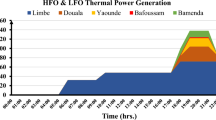
Optimal sizing and location of grid-interfaced PV, PHES, and ultra capacitor systems to replace LFO and HFO based power generations
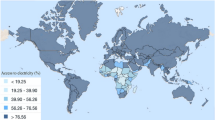
A techno-economic perspective on efficient hybrid renewable energy solutions in Douala, Cameroon’s grid-connected systems
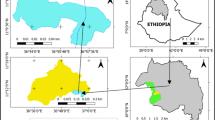
Optimization of off-grid hybrid renewable energy systems for cost-effective and reliable power supply in Gaita Selassie Ethiopia
Introduction, motivation and incitement.
Self-sufficiency in electrical energy is a pillar of development for a country aspiring to be an emerging power. Indeed, the availability of electricity promotes the delivery of essential services such as education, health care, access to communication technologies, and increased agricultural and economic productivity. Nevertheless, according to the International Energy Agency (IEA), the proportion of Cameroon’s population with electricity access in 2021 was merely 65% 1 . The Cameroonian government’s electrification projects have mostly resulted in the electrification of urban centers. Similarly, the towns served by the power grid face issues with reliability and stability. Power outages, load shedding, and voltage drops are common on the electrical grid, causing significant social and economic consequences for the population. In 2021, Cameroon’s power network experienced an average system interruption duration index (SAIDI) of 162.6 h and an average system interruption frequency index (SAIFI) of 41.8 2 . These two indices assess the reliability of Cameroon’s power grid, highlighting its inferior performance compared to more advanced countries such as the United States, where the SAIDI was 4.7 h in 2019 3 . Renewable energies, particularly solar photovoltaic energy, are critical for expanding the population’s access to electricity in a sustainable basis. PV systems produce decarbonized and environmentally friendly electricity, which helps fight global warming. Cameroon has significant solar photovoltaic (PV) potential across its territory. The annual mean solar radiation varies across the country, with the north receiving 5.8 kWh/m 2 and the south receiving 4.9 kWh/m 2 4 , 5 . Utilizing this significant potential could allow for both large-scale energy production for grid-connected systems and smaller, stand-alone systems. However, solar energy is not a panacea for Cameroon’s lack of access to high-quality energy. Solar panel output is highly dependent on the erratic nature of both solar radiation and ambient temperature, which frequently leads to an imbalance between supply and demand. In order to mitigate this issue, storage systems are interconnected with photovoltaic systems to ensure the uninterrupted provision of energy to diverse loads in the event of solar panel failure. Furthermore, adding supplementary power sources, such as diesel generators, can improve the HRES’s reliability. The incorporation of diverse energy sources and storage systems into renewable energy systems significantly impacts the expenses associated with their installation, operation, and maintenance. So, to be appealing, these renewable energy systems must be optimally dimensioned in order to reduce the investment required for installation. This work developed an optimal sizing approach for a HRES composed of batteries, solar panels, and a diesel generator for a residential application in Buea, Cameroon’s southwest region. The system is intended to operate independently of the electrical grid.
Related works
The literature extensively discusses the optimal design of Hybrid Renewable Energy Systems (HRESs), which integrate various energy sources such as solar panels, wind turbines, diesel generators, biogas generators, and storage systems. These systems are designed to provide a reliable and sustainable energy supply by leveraging the complementary nature of different energy sources. For instance, solar panels generate electricity during the day, while wind turbines can produce power both day and night, depending on wind conditions. Diesel and biogas generators serve as backup power sources, ensuring a continuous energy supply even when renewable sources are insufficient.
Determining the appropriate size and configuration of these HRESs is a complex task that involves balancing cost, efficiency, and reliability. Effective methods for sizing these systems often utilize advanced software tools like HOMER (Hybrid Optimization of Multiple Energy Resources) 6 , 7 . HOMER allows users to simulate and optimize the performance of various HRES configurations under different scenarios, helping to identify the most cost-effective and reliable setup 8 .
Additionally, metaheuristic algorithms, such as genetic algorithms, particle swarm optimization, and simulated annealing, are frequently employed to solve the optimization problems associated with HRES design 9 , 10 . These algorithms can efficiently search through large solution spaces to find near-optimal configurations that might be impractical to identify through traditional methods 11 . By combining these tools and techniques, researchers and engineers can design HRESs that meet specific energy demands, minimize costs, and enhance sustainability.
Al-Shamma’a et al. 12 conducted an investigation to look into the possibility of transitioning from diesel-powered to hybrid energy systems in remote areas of Saudi Arabia. This study proposes using PV and wind turbines to reduce costs and increase the use of energy from renewable sources. The researchers used an optimization framework with a genetic algorithm to determine the most efficient hybrid system, taking into account factors such as solar panel rated power, wind turbine nominal power, battery count, and diesel generator rated capacity. The study found that a PV/battery/diesel system is the most cost-effective option for remote locations. Finally, an HRES with PV/battery/diesel saved approximately 60% of fuel compared to a diesel-only system while lowering carbon emissions by approximately 43%.
Rashid et al. 13 sought to develop and assess the feasibility of hybrid energy systems that incorporate biomass energy sources in a remote part of Bangladesh. The study looked at different hybrid system configurations, optimized their sizing and components, and evaluated their techno-economic aspects using a genetic algorithm. The findings show that a solar-based photovoltaic (PV) system with wind, diesel, and biomass backup sources has the lowest levelized cost of energy (LCOE). Furthermore, the study demonstrates that the genetic algorithm (GA) method delivers long-term and cost-effective results when contrasted with HOMER Pro software.
As reported by Ferrari et al. 14 , HRESs have the potential to reduce supply costs and incorporate renewable energy sources for remote off-grid users. By implementing a new sizing strategy for hybrid PV-wind-diesel systems that considers real-world constraints and machine data, the authors were able to optimize the energy mix configurations. This study contributes to the development of dependable techniques for designing hybrid systems, including renewables, energy-storage batteries, and fossil fuel generators. Olatomiwa et al. 15 found that the PV/diesel/battery combination was the most economically feasible choice, exhibiting the smallest fuel consumption and CO 2 emissions.
Makhdoomi and Askarzadeh 16 performed an investigation to assess the techno-environmental feasibility of various HRESs, such as PV/diesel, PV/diesel/battery, and PV/diesel/pumped hydro storage (PHS) configurations. The optimization problem involved two objective functions: LCOE and total primary energy (TPE). The optimal results were determined using multi-objective crow search algorithm (MOCSA). The study indicated that the most economical choice was a PV/diesel/PHS system utilizing fixed panels. Olatomiwa et al. 17 assessed the most suitable dimensions of HRES in various off-grid locations to power healthcare facilities in rural areas of Nigeria. The renewable energy systems considered in this study include solar PV, wind turbines, diesel generators, and storage batteries. The HOMER software was utilized for High Renewable Energy Systems (HRES) sizing. The optimal results revealed that for some locations, the PV-wind-diesel-battery configuration was optimal, while for others, the PV-diesel-battery configuration was most appropriate. This research 18 aimed to conduct an extensive technical and economic evaluation to determine the best approach for hybrid photovoltaic/wind systems integrating various types of energy storage to provide electricity to three particular areas in Cameroon: Fotokol, Figuil, and Idabato. The study utilized the cuckoo search algorithm to identify the optimal hybrid system combination with the cheapest cost of energy and net present cost, while ensuring it meets the load deficit probability. The findings indicated that a battery-based photovoltaic/wind HRES is the most efficient, economical, and dependable configuration for all levels of activity and locations. The researchers in this study 19 sized and analyzed stand-alone HRES that included PV modules and/or wind turbines in Cameroon’s Far North region, where many rural areas lack access to electricity. An analysis of sensitivity was conducted to assess the performance of HRES by examining different parameters such as LPSP, surplus energy ratio, and level of self-sufficiency. Optimization algorithms constitute popular and effective methods to figure out the optimal size of HRES. The Cuckoo Optimization Algorithm (COA) metaheuristic, despite being relatively new, has been successfully applied to solve numerous intricate engineering problems because of its simplicity and resilience 20 , 21 . This algorithm is inspired by the brood parasitism of some cuckoo species and is known for its ability to find optimal solutions efficiently in complex problem spaces 22 .
In addition to COA, other metaheuristic methods such as the Whale Optimization Algorithm (WOA), Sine Cosine Algorithm (SCA), and Grasshopper Optimization Algorithm (GOA) have demonstrated their effectiveness in addressing HRES sizing issues 23 , 24 . These algorithms mimic natural processes and behaviors to explore and exploit search spaces, making them highly suitable for optimizing the design and operation of Hybrid Renewable Energy Systems 25 , 26 . Each of these methods brings unique strengths; for instance, WOA mimics the bubble-net hunting strategy of humpback whales, SCA leverages mathematical sine and cosine functions to navigate the search space, and GOA is inspired by the swarming behavior of grasshoppers 27 . Their application to HRES design helps in achieving balanced, efficient, and sustainable energy systems.
Based on insights gained from an extensive review of the current literature, this study reveals a key gap in solving the energy challenges faced by residential areas in Buea, Cameroon. Despite the abundance of renewable energy resources, the region continues to grapple with an unreliable and unstable electricity grid, leading to frequent power outages and hindered socio-economic development. Existing studies have highlighted the potential of Hybrid Renewable Energy Systems (HRES) to mitigate these issues by harnessing solar energy alongside other renewable sources.
However, the literature reveals a lack of comprehensive research focused on optimizing the design and configuration of HRES specifically tailored for the residential context in Buea. Existing studies often overlook the unique socio-economic and environmental dynamics of the region, thus failing to provide practical solutions that address the specific needs and constraints of local residents. Furthermore, the existing energy management strategies in Buea primarily rely on traditional fossil fuel-based generators as backup power sources, contributing to environmental degradation and exacerbating the region’s vulnerability to climate change impacts. There is a pressing need for innovative, sustainable alternatives that not only ensure reliable energy access but also minimize greenhouse gas emissions and promote resilience in the face of evolving environmental challenges.
Therefore, the research problem addressed in this study revolves around the formulation of an optimal HRES configuration that balances cost-effectiveness, reliability, and environmental sustainability. By integrating insights from the literature review with empirical data and advanced optimization techniques, this research aims to contribute a tailored solution to the energy challenges faced by residential communities in Buea. The study seeks to bridge the gap between theoretical knowledge and practical implementation, thereby offering valuable insights for policymakers, energy planners, and stakeholders involved in sustainable development initiatives in the region.
Objective of the study
This study sought to figure out the optimal dimension of an autonomous PV/Battery/Diesel hybrid system for residential use in Buea, Cameroon, with the goal of enhancing the community’s access to dependable and quality energy. This study utilized the cost of energy as a decision criterion and the loss of power supply probability as a system dependability criterion.
Research contributions of the work
This work makes the following contributions to the literature:
A PV/Battery/Diesel hybrid system was suggested for residential use in Buea, southwest Cameroon. An energy management approach has been proposed to boost the proportion of renewable energy in order to meet demand and restrict greenhouse gas emissions.
The suggested HRES’s size was optimized using the COA meta heuristic in accordance with LPSP and energy cost criteria. Following that, the results were examined in relation to those given by the WOA, SCA, and GOA algorithms.
A comparison was conducted between PV/Battery/Diesel and PV/Battery configurations to identify the most efficient configuration according to cost of energy and LPSP.
A thorough examination was conducted to assess the impact of gradually decreasing the LPSP on energy costs and the capacity of diesel generators. The purpose was to analyze how enhancing the reliability of the proposed hybrid system would affect the cost of energy.
The next sections of this study follow a systematic framework: Section “ Materials and method ” elaborates on the materials and methodology used, outlining the methods and techniques applied. Section “ Result and discussion ” carefully examines the obtained results, providing a thorough analysis of the findings. Finally, Section “ Conclusion and future research directions ” summarizes the study’s findings, combining the insights gained from previous parts.
Materials and method
Load assessment.
Buea is the capital of Cameroon’s Southwest region, located at latitude 4°14″ north and longitude 9°20″ east. The University of Buea, situated in the city, is one of the nation’s top institutions. The city has a significant student population, most of whom reside in private dormitories located near the university. The energy consumption profile of this private university residence, located next to the University of Buea, varies depending on the time period considered. When the university was open, students occupied the majority of accommodations, and energy consumption was the highest. When the university is closed for vacations, energy consumption is low. Figure 1 shows the two measured daily energy consumption profiles. The long vacations take place from mid-July to mid-September, while the inter-semester vacations take place in February. The highest demand was 8.066 kW, while the lowest was 1.7 kW.

Hourly load profile during vacation period and during normal period.
Solar resource assessment
Cameroon receives abundant sunshine across its territory. Despite being situated in the southern region, Buea receives ample sunlight, which makes it suitable for the implementation of photovoltaic systems. Figure 2 displays the monthly solar radiation data and monthly average ambient temperature, acquired from 28 .
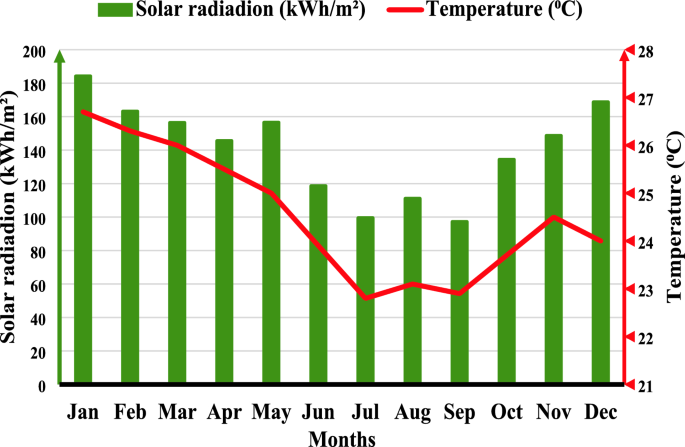
Buea monthly solar radiation data and monthly average ambient temperature.
Proposed hybrid renewable energy system
The autonomous HRES consisted of solar photovoltaic panels, lithium batteries, and a diesel generator is shown in Fig. 3 .
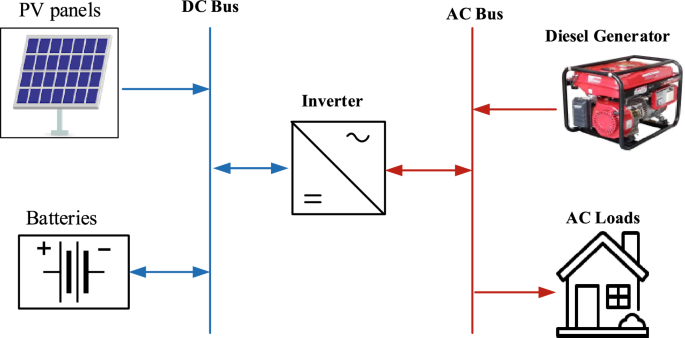
Layout of the proposed HRES.
Mathematical modeling of renewable system
Pv solar system.
Equation ( 1 ) provides the power generated by the photovoltaic system 29 , 30 .
where, \({P}_{STC}\) represents the nominal power of the solar panel, \({N}_{PV}\) indicates the number of solar panels, Ir is the solar radiation at the chosen location, \({T}_{C}\) stands for the cell temperature, \({\alpha }_{p}\) indicates the temperature coefficient and \({F}_{losses}\) quantifies the reduction in efficiency of solar panels caused by factors such as dirt and shading. In this study, this variable was assigned a value of 0.95 31 .
The temperature \({T}_{C}\) of the cells is determined by solar radiation, the ambient temperature, and the normal operating cell temperature ( \(NOCT)\) .
- Diesel generator
The quantity of fuel used by a diesel generator significantly impacts its performance. This study assumes a linear fuel consumption curve, as referenced in 32 . Equation ( 3 ) calculates the fuel consumption per hour ( \({D}_{f}(t)\) ).
where the diesel generator’s nominal capacity is denoted by \({P}_{Dgr}\) , while the power generated at time t is represented by \({P}_{Dg}\) . The fuel curve’s slope \({\alpha }_{D}\) is expressed in L/kW, and its intercept coefficient is denoted by \({\beta }_{D}\) . The values of \({\alpha }_{D}\) and \({\beta }_{D}\) considered in this study were 0.246 and 0.08145 respectively 32 . The diesel generator is assumed to run at least 30% of its rated capacity for the purposes of this study. The lifespan of the diesel generator is determined by the number of hours it runs per year. Equations ( 4 ) and ( 5 ) represent the running time ( \({RT}_{Diesel}\) ) and the lifespan of the diesel generator, respectively.
Storage system
The battery system has two modes.
Charging mode. Surplus energy is utilized for charging the batteries. The battery-charging power was calculated using two equations.
If production (PV system and diesel generator) surpasses demand and the diesel generator’s output alone is insufficient to meet demand, Eq. ( 6 ) is used to calculate how much energy needed for charging the batteries 63 , 64 .
When the power produced by the diesel generator is higher than the load demand, Eq. ( 7 ) is utilized to charge the batteries.
The inverter under consideration is bidirectional, with the assumption that its efficiency is the same in both DC/AC and AC/DC conversion modes.
Discharging mode. Batteries are discharged when the PV panels and/or diesel generator are unable to meet the entire load requirement 61 .
The energy available in the batteries is given by Eq. ( 9 ) 33 .
In Eqs. ( 6 )–( 9 ), the symbols \({\eta }_{ch}\) and \({\eta }_{dis}\) are used to represent the battery charging efficiency and battery discharging efficiency, respectively. The inverter conversion efficiency is represented by \({\eta }_{inv}\) , while the nominal battery capacity is denoted as \({E}_{bat}^{max}\) . The minimum energy quantity is referred to as \({E}_{bat}^{min}\) , and the battery self-discharge is represented by \(\sigma\) . The minimum battery energy depends on the depth of discharge (DOD). By utilizing Eq. ( 10 ), the value can be computed.
The amount of energy available over time in the batteries is constrained by the following factors:
The DC/AC converter has to be capable of supplying the power required by the load.
Here, \({P}_{invn}\) denotes the inverter’s rated power, and \({k}_{SF}\) is a safety factor that must be greater than one.
Reliability model
The metric employed to evaluate the reliability of the HRES is the loss of power supply probability (LPSP), which measures the probability of power supply failure.
Loss of power supply probability
The Loss of Power Supply Probability (LPSP) criterion has been used in numerous studies 34 , 35 . This criterion is essential for evaluating the reliability of Hybrid Renewable Energy Systems (HRESs), as it measures the probability that the system will fail to meet the energy demand 36 , 37 .
Equation ( 13 ) was employed to compute this criterion in this study 38 , 39 .
Economics models
The economic feasibility of the new hybrid system was evaluated based on two criteria: total annualized cost (TAC) along with the cost of energy (COE).
The total annualized cost (TAC)
The total annualized cost of the HRES encompass the initial capital expenditure required for its installation ( \({C}_{CAP}\) ), the cost associated with replacing the batteries and diesel generator ( \({C}_{REP}\) ), and the ongoing operational and maintenance costs ( \({C}_{O\&M}\) ) for all components of the HRES 40 , 41 .
The TAC is calculated for each component of the HRES.
PV system. The total yearly cost of the photovoltaic system encompasses solely the initial cost ( \({C}_{cap}^{PV}\) ) and the yearly expenses for maintenance and operation ( \({C}_{O\&M}^{PV}\) .), as the solar panels’ lifespan aligns with the project’s lifespan.
The \(CRF\) , which stands for capital recovery factor, is determined by utilizing Eq. ( 16 ).
where r represents the real interest rate while N denote the duration of the project.
The real interest rate is calculated based on the nominal interest rate \({i}_{n}\) and the inflation rate \({i}_{f}\) 42 .
Batterie system. The total annualized cost of the batteries includes the cost of the capital \({C}_{cap}^{Bat}\) , required for installing the batteries, the cost of replacing the batteries \({C}_{rep}^{Bat}\) , and the costs of operating and maintaining the batteries \({C}_{O\&M}^{Bat}\) 58 , 59 .
\({k}_{r}\) represents the discount factor for component replacement cost. It is determined by the project lifespan, real interest rate, and component lifespan. Equation ( 19 ) describes this expression.
where \({N}_{rep}\) is the number of component replacements and \(n\) is the lifetime of the component.
Diesel generator. The overall cost of the diesel generator takes into account the initial investment, the expenses for maintenance and operation, as well as the fuel costs ( \({Cost}_{fuel}\) ). The calculation was made using Eq. ( 20 ).
Inverter. The TAC of the inverter encompasses the initial capital, subsequent replacement costs, and ongoing maintenance and operational costs.
Cost of energy (COE)
The cost of energy is calculated by dividing the total annualized cost by the amount of energy delivered to the load ( \({Energy}_{served}\) ). Equation ( 22 ) is utilized to calculate it 43 , 44 .
Optimization problem
The single-objective optimization problem is to minimize the energy cost of the HRES. The problem of optimization is mathematically represented by Eq. ( 23 ).
This single objective optimization problem is subject to the constraints presented in Eq. ( 24 ).
\({N}_{PV}^{L}\) , \({E}_{Bat}^{L}\) , \({P}_{diesel}^{L}\) represent the lower bounds of the optimization variables. \({N}_{PV}^{U}\) , \({E}_{Bat}^{U}\) , \({P}_{diesel}^{U}\) , represent the upper bounds of the optimization variables.
Optimization algorithms
Crayfish optimization algorithm (coa).
The Crayfish Optimization Algorithm (COA) is a computational model that emulates the behavioral patterns of crayfish, specifically focusing on their resorting, competitive, and foraging abilities. To ensure equilibrium between the algorithm’s exploration and operation, the three behaviors were segregated into three separate stages 62 . The sequential procedures involved in the COA for addressing optimization problems are outlined in reference 45 :
Step 1 Setting parameters and initializing the population.
The values for the number of iterations (T), population (N), dimension (dim), and upper and lower bounds (ub, lb) are established. Establish the initial population X by considering the upper and lower bounds. The population initialization is determined using Eqs. ( 25 ) and ( 26 ).
Here, the variable \(X\) denotes the initial population, \({X}_{i,j}\) denotes the position of individual \(i\) within dimension \(j\) , \({lb}_{j}\) and \({ub}_{j}\) represent the lower and upper limits of dimension j, and the variable rand is a randomly generated number 65 .
Step 2 Setting the temperature.
Equations ( 27 ) and ( 28 ) specify the ambient temperature ( \(temp\) ) of the crayfish, which influences the progression of COA through different stages.
Here, the variable \(\mu\) denotes the ideal temperature for crayfish, while \(\sigma\) and \({C}_{1}\) govern the consumption of crayfish at different temperatures.
Step 3 Summer resort and competition stages.
If \(temp>30\) and rand drops below 0.5, the COA transitions to the resort stage. The COA computes a new position ( \({X}_{i,j}^{t+1}\) ) by utilizing the cave position ( \({X}_{shade}\) ) and crayfish position ( \({X}_{i,j}^{t}\) ). Equations ( 29 ), ( 30 ), and ( 31 ) allow computation of the new position. Next, we proceed to Step 5.
Here, \({X}_{G}\) indicates the current optimal position attained after a specific number of iterations, \({X}_{L}\) indicates the current population’s optimal position, \(t\) denotes the present iteration’s number and \(t+1\) denotes the iteration number for the following generation. \({C}_{2}\) exhibits a declining trend.
The COA entered the competitive phase when \(temp>30\) and rand was 0.5 or higher. Currently, the two crayfish engage in a competition for the cave by utilizing Eqs. ( 32 ) and ( 33 0. This competition leads to the establishment of a new position, denoted as \({X}_{i,j}^{t+1}\) , which is determined by the cave position ( \({X}_{shade}\) ) and the positions of the two crayfish ( \({X}_{i,j}^{t}\) , \({X}_{z,j}^{t}\) ). Then proceed to Step 5.
Here, \(z\) represents a randomly selected crayfish individual.
Step 4 foraging phase.
If \(temp\le 30\) , the COA transitions into the foraging phase, where the consumption of food p and the size of the food \(Q\) are determined by Eqs. ( 34 ) and ( 35 ) 60 .
If \(Q>{(C}_{3}+1)/2\) , the food is shared using Eq. ( 36 ). Then use Eq. ( 37 ) to calculate the new position and proceed to Step 5.
If \(Q<{(C}_{3}+1)/2\) , use Eq. ( 38 ) to find a new position and move on to Step 5.
Step 5 Evaluation function.
Assess the population and decide if to break the cycle. Otherwise, go back to Step 2.
Step 6 Displaying the optimal fitness value.
Other algorithms
The WOA 46 , SCA 47 , and GOA 48 are three additional meta-heuristics employed to address this optimization problem.
The initial settings of the algorithms are displayed in Table 1 .
Energy management of the hybrid system
The most suitable design of the hybrid renewable energy system is heavily dependent on the strategic management of power flow between demand and the two sources of energy production, which include batteries. Solar panels are the primary source of power for meeting load demand, with lithium batteries serving as a secondary option. The diesel generator serves as a backup energy source, providing power to the load only when the PV system and batteries are unable to do so. This reduces the emission of greenhouse gases into the environment. The various stages of the energy management strategy are as follows:
If \({P}_{PV}\left(t\right)=\frac{{P}_{Load}\left(t\right)}{{\eta }_{inv}}\) , the solar panels’ generation is adequate to meet the load demand.
If \({P}_{PV}\left(t\right)>\frac{{P}_{Load}\left(t\right)}{{\eta }_{inv}}\) , excess energy is utilized for the purpose of charging the batteries.
If \({P}_{PV}\left(t\right)<\frac{{P}_{Load}\left(t\right)}{{\eta }_{inv}}\) , the state of charge of the battery is assessed.
If the amount of energy stored in the battery at the preceding moment is adequate to satisfy the demand \(\left({P}_{PV}\left(t\right)-\frac{{P}_{Load}(t)}{{\eta }_{inv}}\right)\) , then the batteries are discharged.
Insufficient energy stored in the batteries triggers the activation of the diesel generator to supply the required power for the load, and any surplus energy will be utilized to recharge the batteries.
In the event that the diesel generator is incapable of meeting the entirety of the load demand, and the battery state-of-charge does not meet the minimum threshold established by the DOD, the combined efforts of the diesel generator and the diesel generator and batteries work together to fulfill the entire load demand.
The energy management applied to the proposed HRES is depicted in Fig. 4 .
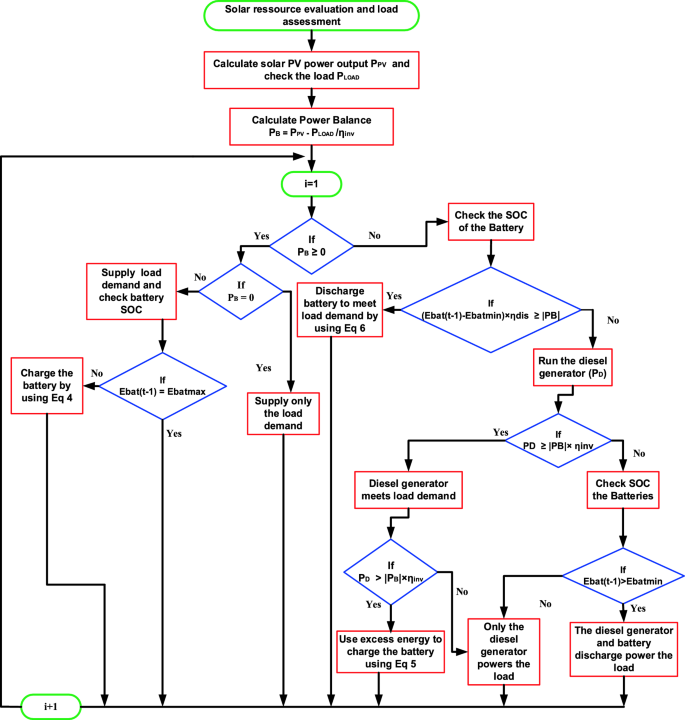
Proposed energy management strategy for the HRES.
Economic and technical specifications of the different components
Table 2 lists the economic, technical, and financial features of the diesel generator, battery, and photovoltaic solar panel.
Result and discussion
Figure 5 displays the meteorological data for Buea, including hourly solar radiation and hourly ambient temperature over a 1-year timeframe 53 .
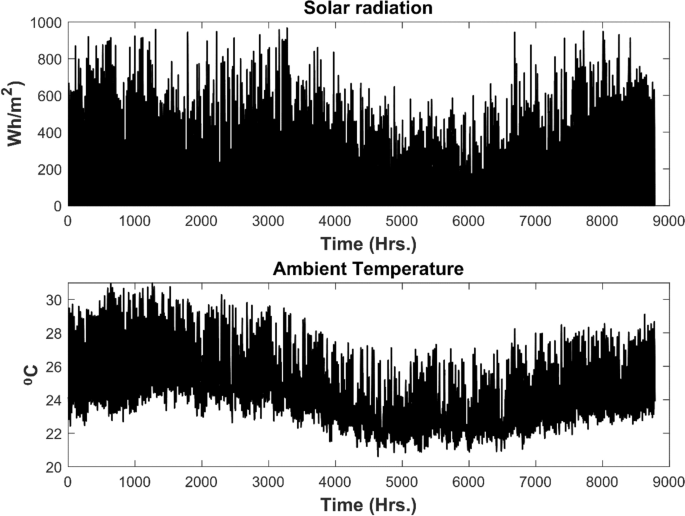
Hourly solar radiation and ambient temperature for the city of Buea.
Two different hybrid renewable energy configurations were tested to determine the best configuration. These are the PV-Battery-Diesel and PV-Battery configurations. Four metaheuristics are used to find the best size for each HRES configuration. Next, the best results for each configuration are compared. Figure 6 depicts the results of using the four metaheuristics to solve optimization problems.
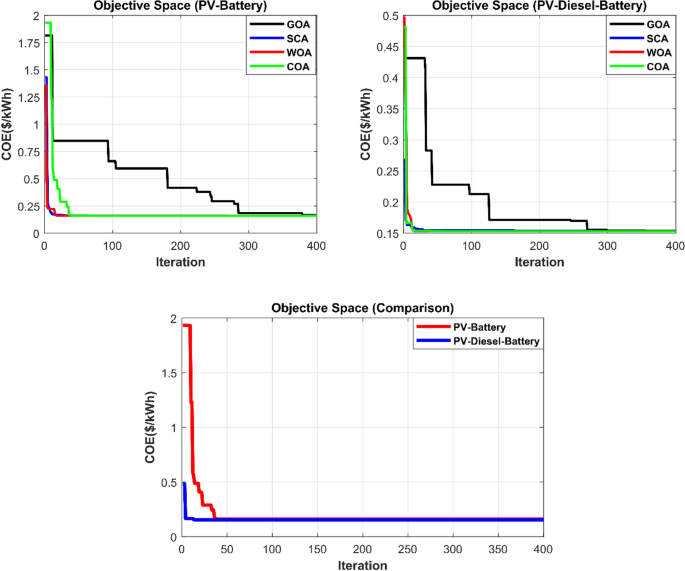
Results obtained for COA, WOA, SCA, and GOA algorithms.
In accordance with the results depicted in Fig. 6 , the COA algorithm yielded the best outcomes irrespective of the HRES type being evaluated. The costs of energy determined with the four algorithms for the PV-Battery hybrid option converge to their optimal values as the number of iterations increases. Using the COA, WOA, SCA, and GOA algorithms, respectively, COEs of 0.1599 $/kWh, 0.16 $/kWh, 0.1601 $/kWh, and 0.1615 $/kWh were determined. Furthermore, the energy costs of the COA algorithm were reduced by 0.06%, 0.12%, and 1% compared to the energy costs achieved using the WOA, SCA, and GOA algorithms, respectively.
In the context of the PV-Battery-Diesel hybrid option, the COA algorithm demonstrated superior performance, yielding COEs of 0.1530$/kWh, 0.1531$/kWh, 0.1532$/kWh, and 0.1536$/kWh when the COA, WOA, SCA, and GOA algorithms were employed, respectively. It can be observed that the energy costs of the COA algorithm are 0.065%, 0.13%, and 0.39% less compared to the WOA, SCA, and GOA algorithms, correspondingly. In both the PV-Lithium Battery and PV-Lithium Battery-Diesel hybrid system configurations, the superior performance of the COA technique was observed compared to the WOA, SCA, and GOA algorithms. Figure 6 depicts the comparison of the results produced by the COA algorithm for the two configurations.
After conducting a comparative analysis of the optimal outcomes for each configuration, it came out that the PV-Battery-Diesel system exhibited superior performance with regard to both cost of energy and total annualized cost. The COE for the PV-Battery System was 0.1599 $/kWh, while the PV-Battery-Diesel System had a COE of 0.153 $/kWh. The COE achieved for the PV-Battery-Diesel system was 4.5% less compared to the PV-Battery system. Additionally, the total annualized cost (TAC) achieved using the PV-Battery configuration was $4444.90, while the PV-Battery-Diesel configuration yielded a TAC of $4251.98. Nevertheless, the PV-Battery-Diesel system releases a total of 1409.6 kg of carbon dioxide annually, based on a CO2 emission rate of 1.94 kg/kWh 54 , as a result of employing a diesel generator.
The PV-Battery-Diesel configuration exhibited superior economic performance compared to the PV-battery configuration. Prior research has yielded similar findings 55 , 56 . Regarding the COE obtained in this study compared to those reported in the literature, there is a wide range of results depending on the geographical location of the case study, the type of load profile, and the economic parameters taken into account for the analysis. For example, research conducted in China 57 resulted in a COE of $0.26/kWh. However, in reference 52 , the cost of energy for a specific study conducted in Iraq was $0.152/kWh. The COE achieved in this study is $0.153/kWh, which is within the same range of values.
Table 3 presents the detailed results generated by each algorithm. Due to the main focus of minimizing energy costs, the PV-Lithium Battery-Diesel setup was selected, and the subsequent analysis exclusively concentrated on this configuration.
The effect of the gradual reduction in LPSP on COE was investigated. The goal is to investigate the potential cost implications of increasing the reliability of the PV-Battery-Diesel hybrid system. The COA algorithm is used to generate the results shown in Fig. 7 .
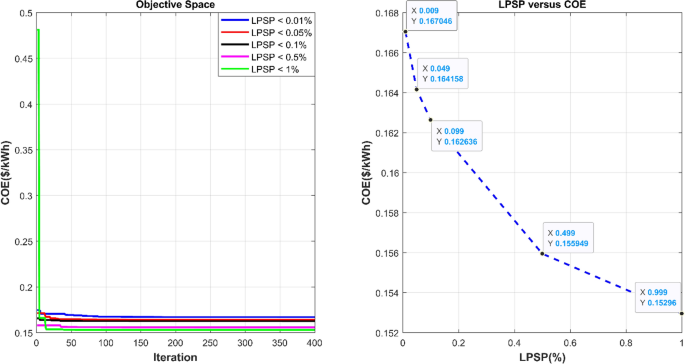
Results obtained when decreasing LPSP toward zero.
As shown in Fig. 7 , the gradual decrease in LPSP led to a gradual increase in COE from 0.153$/kWh for an LPSP of 0.998% to 0.1670 $/kWh for an LPSP of 0.009%. Table 4 presents the detailed results of the LPSP reduction in the COE.
The data in Table 4 show that as the LPSP decreases, there is a corresponding increase in the COE and the total annualized cost of the system. The rise in energy costs as LPSP approaches zero is due to the growth in the nominal capacity of the diesel generator. The diesel generator’s nominal capacity increases from 1.76 at a 0.998% LPSP to 5.74 kW at a 0.009% LPSP. The findings indicated that the gradual decrease in LPSP primarily affected the rated capacity of the diesel generator. The solar PV system capacity ranged from 36.56 kW for 0.998% LPSP (LPSP < 1%) to 38.02 kW for 0.009% LPSP (LPSP < 0.01%). The storage system capacity showed minimal variation despite the decrease in LPSP. The renewable energy fraction decreased as LPSP decreased. The CO 2 emissions were approximately 1,953.6 kg for the 0.009% LPSP, in contrast to 1,409.6 kg for the 0.99% LPSP. By maintaining the LPSP results at 0.009% and aligning the nominal capacity of the diesel generator with the maximum load demand (8.066 kW), a system with complete reliability (LPSP = 0%) was achieved. Figure 8 shows the relationship among diesel generator rated capacity, energy cost, and LPSP. This energy management strategy utilized a diesel generator as an energy backup system to minimize GHG emissions.
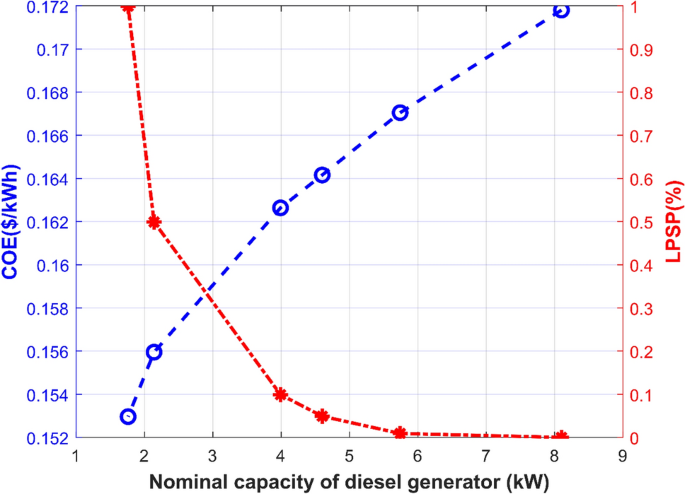
Impact of the size of diesel generator on COE and LPSP.
Increasing the rated capacity of the diesel generator in Fig. 8 results in a higher COE and a decrease in the LPSP towards zero. At a diesel generator rated power output of 8.066 kW, which represents the peak load demand, the LPSP dropped to zero and the energy cost was 0.1718 kWh. The findings of the study indicate that the diesel generator plays a significant role in enhancing the dependability of the hybrid system under investigation. A comprehensive examination of the outcomes acquired for LPSP < 1% and LPSP = 0% was conducted. Figure 9 illustrates the yearly amounts of energy generated/consumed by the PV, diesel, and battery systems.
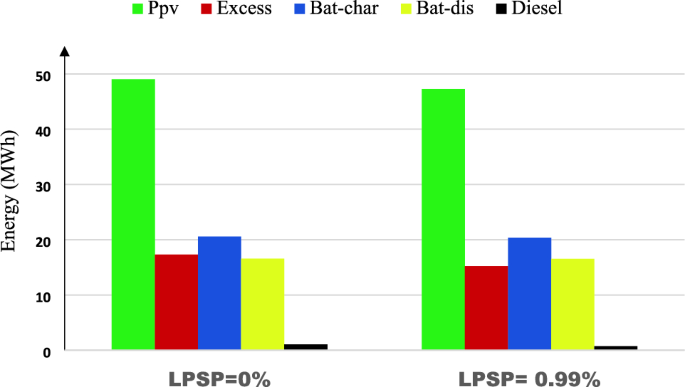
Annual energy generation/consumed for the LPSP = 0% and LPSP = 0.99%.
When LPSP was 0%, the PV system produced 49.04 MWh annually. Of this, 16.92 MWh was surplus energy, 20.55 MWh was used for battery charging, and 11.57 MWh was directly supplied to the load by the solar panels through the inverter. The battery supplied 16.66 MWh of energy to the load via the inverter annually, while the diesel generator produced 1.042 MWh of energy per year. The annual energy demand was 27.80 MWh. The diesel generator provides approximately 3.7% of the total annual energy demand.
When LPSP was 0.99%, the PV system produced 47.26 MWh annually. Of this, 15.2 MWh was surplus energy, 20.32 MWh was used to charge the batteries, and 11.70 MWh was directly supplied to the load via the inverter. The diesel generator produced 0.727 MWh of energy annually, while the battery supplied 16.52 MWh of energy to the load through the inverter. The diesel generator provided approximately 2.6% of the overall annual energy demand.
The annual generation of the diesel generator was minimal compared to the energy produced by the solar panels and batteries in the two LPSPs analyzed. The energy management strategy implemented in this study aimed to optimize the utilization of renewable energy sources instead of diesel. The diesel generators ran for 441 h and consumed 241.96 L of diesel with LPSP = 0.99%, whereas they ran for 348 h and consumed 485.91 L of diesel with LPSP = 0%.
Figures 10 and 11 show the energy production of the PV system, battery charging/discharging energy, and diesel generator for LPSP = 0% and LPSP = 0.99% over a 1-day period with minimal sunlight.
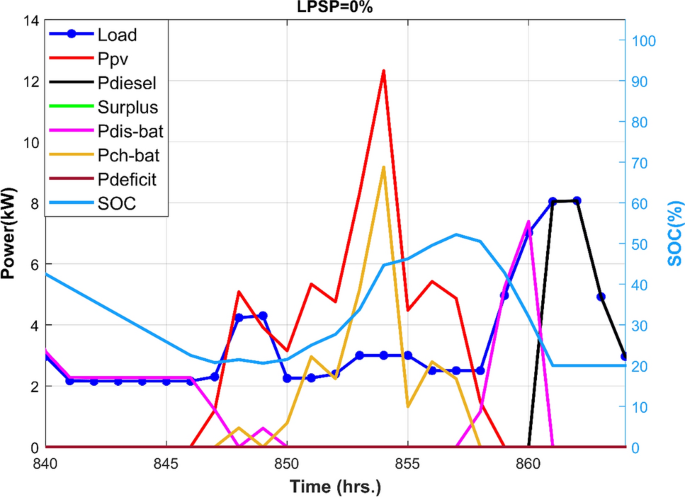
24-h solar PV, battery, and diesel generator energy production for LPSP = 0%.
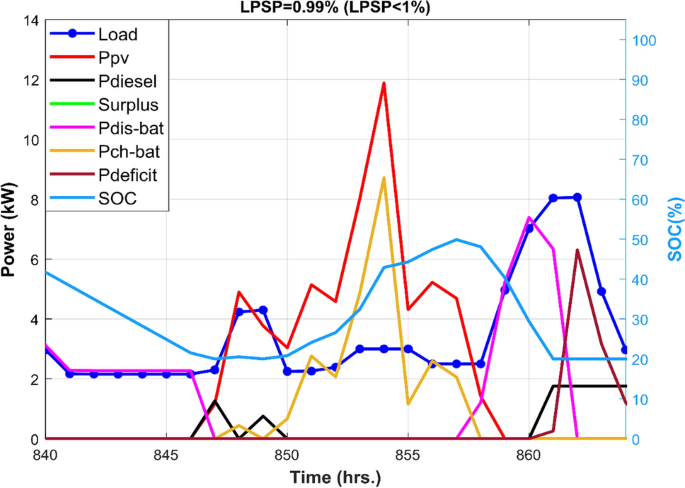
24-h solar PV, battery, and diesel generator energy production for LPSP = 0.99%.
Figure 10 illustrates that the diesel generator is utilized only when the storage system can no longer fulfill the demand in the LPSP = 0% scenario. Given that the LPSP is 0%, the nominal capacity of the diesel generator is adequate to fulfill all demands, resulting in no energy deficit. Conversely, when the LPSP is 0.99% (LPSP < 1%), the nominal capacity of the diesel generator is significantly lower than demand. When the batteries can no longer meet the demand, an energy deficit occurs, as shown in Fig. 11 .
Figure 11 demonstrates that the diesel generator is utilized more when LPSP is 0.998% compared to when it is zero. In the 0.998% LPSP scenario, the diesel generator operated for a greater duration compared to the zero LPSP scenario.
Conclusion and future research directions
In conclusion, this study explored the optimization of an autonomous hybrid renewable energy system for residential use in Buea, Cameroon. The optimal dimensions of a HRES intended for residential use were investigated in this study. The evaluation involved two hybrid system configurations: PV-Battery and PV-Battery-Diesel. The techno-economic decision criterion selected for the single-objective optimization problem was the cost of energy (COE), while the dependability constraint used was the loss of supplied power probability (LPSP). To optimize and compare the two hybrid system configurations, the COA algorithm was employed. A comparison was made between the outcomes of the COA algorithm and those of established algorithms such as the WOA, SCA, and GOA. Based on the findings, the algorithms yielded energy costs of 0.1599$/kWh, 0.160$/kWh, 0.1601$/kWh, and 0.1615$/kWh for the COA, WOA, SCA, and GOA configurations, respectively. Compared to the COE produced by the WOA, SCA, and GOA algorithms, the COE derived from the COA algorithm is 0.06%, 0.12%, and 1% lower. In a similar vein, the algorithms yield COE values of 0.1530 $/kWh, 0.1531 $/kWh, 0.1532 $/kWh, and 0.1555 $/kWh for the COA, WOA, SCA, and GOA configurations, respectively. The COE achieved through the COA algorithm was 0.065%, 0.13%, and 0.39% less than the COEs achieved from the WOA, SCA, and GOA algorithms, separately. Upon comparing the optimal outcomes yielded by the COA algorithm for the two hybrid system configurations, it was Witnessed that the PV-Battery-Diesel configuration exhibited the most favorable coefficient of efficiency (COE). Furthermore, an analysis of the effect of gradually decreasing LPSP on COE in the PV-Battery-Diesel configuration revealed that COE tends to rise as LPSP decreases. The rise in the COE can be attributed to an augmentation in the nominal capacity of the diesel generator. Therefore, once the diesel generator’s nominal capacity reached the highest energy demand, the hybrid system achieved full reliability, with LPSP = 0.
In considering future research directions, several promising paths emerge to advance the field of hybrid renewable energy systems. Firstly, exploring advanced optimization techniques such as genetic algorithms, particle swarm optimization, or machine learning-based approaches could refine HRES design and operation. Secondly, integrating emerging technologies like advanced energy storage systems and smart grid technologies into HRES could enhance system performance and reliability. Thirdly, investigating the socio-economic impacts and policy implications of HRES deployment, along with field studies and pilot projects, can provide valuable insights into the practical feasibility and benefits of renewable energy adoption. By addressing these areas, future research can contribute to the development of innovative solutions for sustainable energy provision and accelerate the transition towards a low-carbon and resilient energy future.
Data availability
The datasets used and/or analysed during the current study available from the corresponding author on reasonable request.
Jacques Fotso, W., Mvogo, G. & Bidiasse, H. Household access to the public electricity grid in Cameroon: Analysis of connection determinants. Util. Policy 81 , 101514. https://doi.org/10.1016/j.jup.2023.101514 (2023).
Article Google Scholar
Eneo-Annual-Review-2021.pdf. Accessed: 13 Mar 2024. [Online]. Available: https://eneocameroon.cm/images/Eneo-Annual-Review-2021.pdf
U.S. power customers experienced an average of nearly five hours of interruptions in 2019 - U.S. Energy Information Administration (EIA). Accessed: 13 Mar 2024. [Online]. Available: https://www.eia.gov/todayinenergy/detail.php?id=45796
Muh, E., Amara, S. & Tabet, F. Sustainable energy policies in Cameroon: A holistic overview. Renew. Sustain. Energy Rev. 82 , 3420–3429. https://doi.org/10.1016/j.rser.2017.10.049 (2018).
Amoussou, I. et al. Optimal modeling and feasibility analysis of grid-interfaced solar PV/wind/pumped hydro energy storage based hybrid system. Sustainability 15 (2), 1222. https://doi.org/10.3390/su15021222 (2023).
Hu, F. et al. Research on the evolution of China’s photovoltaic technology innovation network from the perspective of patents. Energy Strategy Rev. 51 , 101309. https://doi.org/10.1016/j.esr.2024.101309 (2024).
Yang, Y. et al. Whether rural rooftop photovoltaics can effectively fight the power consumption conflicts at the regional scale – A case study of Jiangsu Province. Energy Build. 306 , 113921. https://doi.org/10.1016/j.enbuild.2024.113921 (2024).
Rekioua, D. et al. Coordinated power management strategy for reliable hybridization of multi-source systems using hybrid MPPT algorithms. Sci. Rep. 14 , 10267. https://doi.org/10.1038/s41598-024-60116-4 (2024).
Article ADS CAS PubMed PubMed Central Google Scholar
Kanouni, B. et al. Advanced efficient energy management strategy based on state machine control for multi-sources PV-PEMFC-batteries system. Sci. Rep. 14 , 7996. https://doi.org/10.1038/s41598-024-58785-2 (2024).
Agajie, T. F. et al. Enhancing Ethiopian power distribution with novel hybrid renewable energy systems for sustainable reliability and cost efficiency. Sci. Rep. 14 , 10711. https://doi.org/10.1038/s41598-024-61413-8 (2024).
Yang, C. et al. Optimized integration of solar energy and liquefied natural gas regasification for sustainable urban development: Dynamic modeling, data-driven optimization, and case study. J. Clean. Prod. https://doi.org/10.1016/j.jclepro.2024.141405 (2024).
Al-Shamma’a, A. A., Alturki, F. A. & Farh, H. M. H. Techno-economic assessment for energy transition from diesel-based to hybrid energy system-based off-grids in Saudi Arabia. Energy Transit. 4 (1), 31–43. https://doi.org/10.1007/s41825-020-00021-2 (2020).
Rashid, F. et al. Investigation of optimal hybrid energy systems using available energy sources in a rural area of Bangladesh. Energies 14 (18), 5794. https://doi.org/10.3390/en14185794 (2021).
Article CAS Google Scholar
Ferrari, L., Bianchini, A., Galli, G., Ferrara, G. & Carnevale, E. A. Influence of actual component characteristics on the optimal energy mix of a photovoltaic-wind-diesel hybrid system for a remote off-grid application. J. Clean. Prod. 178 , 206–219. https://doi.org/10.1016/j.jclepro.2018.01.032 (2018).
Olatomiwa, L., Mekhilef, S., Huda, A. S. N. & Ohunakin, O. S. Economic evaluation of hybrid energy systems for rural electrification in six geo-political zones of Nigeria. Renew. Energy 83 , 435–446. https://doi.org/10.1016/j.renene.2015.04.057 (2015).
Makhdoomi, S. & Askarzadeh, A. Techno-enviro-economic feasibility assessment of an off-grid hybrid energy system with/without solar tracker considering pumped hydro storage and battery. IET Renew. Power Gener. 17 (5), 1194–1211. https://doi.org/10.1049/rpg2.12675 (2023).
Olatomiwa, L., Blanchard, R., Mekhilef, S. & Akinyele, D. Hybrid renewable energy supply for rural healthcare facilities: An approach to quality healthcare delivery. Sustain. Energy Technol. Assess. 30 , 121–138. https://doi.org/10.1016/j.seta.2018.09.007 (2018).
Koholé, Y. W., Wankouo Ngouleu, C. A., Fohagui, F. C. V. & Tchuen, G. Quantitative techno-economic comparison of a photovoltaic/wind hybrid power system with different energy storage technologies for electrification of three remote areas in Cameroon using Cuckoo search algorithm. J. Energy Storage 68 , 107783. https://doi.org/10.1016/j.est.2023.107783 (2023).
Arias, A. R., Woodward, L., Viglione, L. & Primiani, P. Sizing and performance analysis of a standalone hybrid renewable energy system in the Far North Region of Cameroon. in 2023 IEEE Green Technologies Conference (GreenTech) 176–180 (2023). https://doi.org/10.1109/GreenTech56823.2023.10173816 .
Jovanovic, L., Bacanin, N., Zivkovic, M., Antonijevic, M., Petrovic, A. & Zivkovic, T. Anomaly detection in ECG using recurrent networks optimized by modified metaheuristic algorithm. in 2023 31st Telecommunications Forum (℡FOR) 1–4 2023). https://doi.org/10.1109/℡FOR59449.2023.10372802 .
Cheng, Y. Design and use of deep confidence network based on crayfish optimization algorithm in automatic assessment method of hearing effectiveness. ICST Trans. Scalable Inf. Syst. https://doi.org/10.4108/eetsis.4847 (2024).
Jose, S. S., Sugitha, G. G., Lakshmi, S. A. & Chaluvaraj, P. B. Self-Attention conditional generative adversarial network optimised with crayfish optimization algorithm for improving cyber security in cloud computing. Comput. Secur. 140 , 103773. https://doi.org/10.1016/j.cose.2024.103773 (2024).
Hermann, D. T., Donatien, N., Armel, T. K. F. & René, T. A feasibility study of an on-grid PV/wind/battery/diesel for residential buildings under various climates in cameroon. Energy Technol. 9 (12), 2100615. https://doi.org/10.1002/ente.202100615 (2021).
Yan, C., Zou, Y., Wu, Z. & Maleki, A. Effect of various design configurations and operating conditions for optimization of a wind/solar/hydrogen/fuel cell hybrid microgrid system by a bio-inspired algorithm. Int. J. Hydrogen Energy 60 , 378–391. https://doi.org/10.1016/j.ijhydene.2024.02.004 (2024).
Article ADS CAS Google Scholar
Jahannoush, M. & Arabi Nowdeh, S. Optimal designing and management of a stand-alone hybrid energy system using meta-heuristic improved sine–cosine algorithm for Recreational Center, case study for Iran country. Appl. Soft Comput. 96 , 106611. https://doi.org/10.1016/j.asoc.2020.106611 (2020).
Rekioua, D. et al. Optimization and intelligent power management control for an autonomous hybrid wind turbine photovoltaic diesel generator with batteries. Sci. Rep. 13 , 21830. https://doi.org/10.1038/s41598-023-49067-4 (2023).
Shirkhani, M. et al. A review on microgrid decentralized energy/voltage control structures and methods. Energy Rep. 10 , 368–380. https://doi.org/10.1016/j.egyr.2023.06.022 (2023).
JRC Photovoltaic Geographical Information System (PVGIS) - European Commission. Accessed: 28 Feb. 2024. [Online]. Available: https://re.jrc.ec.europa.eu/pvg_tools/en/
Bukar, A. L., Tan, C. W. & Lau, K. Y. Optimal sizing of an autonomous photovoltaic/wind/battery/diesel generator microgrid using grasshopper optimization algorithm. Sol. Energy 188 , 685–696. https://doi.org/10.1016/j.solener.2019.06.050 (2019).
Article ADS Google Scholar
Singh, S., Chauhan, P. & Singh, N. Capacity optimization of grid connected solar/fuel cell energy system using hybrid ABC-PSO algorithm. Int. J. Hydrog. Energy 45 (16), 10070–10088. https://doi.org/10.1016/j.ijhydene.2020.02.018 (2020).
Amoussou, I. et al. The optimal design of a hybrid solar PV/wind/hydrogen/lithium battery for the replacement of a heavy fuel oil thermal power plant. Sustainability 15 (15), 11510. https://doi.org/10.3390/su151511510 (2023).
Eltamaly, A. M. & Mohamed, M. A. 8 Optimal sizing and designing of hybrid renewable energy systems in smart grid applications. In Advances in Renewable Energies and Power Technologies (ed. Yahyaoui, I.) 231–313 (Elsevier, 2018). https://doi.org/10.1016/B978-0-12-813185-5.00011-5 .
Chapter Google Scholar
Mohseni, S., Brent, A., Burmester, D. & Chatterjee, A. Optimal sizing of an islanded micro-grid using meta-heuristic optimization algorithms considering demand-side management. in 2018 Australasian Universities Power Engineering Conference (AUPEC) 1–6 (2018). https://doi.org/10.1109/AUPEC.2018.8757882 .
Mohapatra, B. et al. Optimizing grid-connected PV systems with novel super-twisting sliding mode controllers for real-time power management. Sci. Rep. 14 , 4646. https://doi.org/10.1038/s41598-024-55380-3 (2024).
Deghfel, N. et al. A new intelligently optimized model reference adaptive controller using GA and WOA-based MPPT techniques for photovoltaic systems. Sci. Rep. 14 , 6827. https://doi.org/10.1038/s41598-024-57610-0 (2024).
Article ADS CAS PubMed Google Scholar
Nagarajan, K. et al. Optimizing dynamic economic dispatch through an enhanced Cheetah-inspired algorithm for integrated renewable energy and demand-side management. Sci. Rep. 14 , 3091. https://doi.org/10.1038/s41598-024-53688-8 (2024).
Amoussou, I., Agajie, T. F., Tanyi, E. & Khan, B. Technical and economic study of the replacement of LFO thermal power plant by hybrid PV-PHSS system in Northern Cameroon. Energy Rep. 9 , 178–194. https://doi.org/10.1016/j.egyr.2022.11.181 (2023).
Amoussou, I., Tanyi, E., Agajie, T., Khan, B. & Bajaj, M. Optimal sizing and location of grid-interfaced PV, PHES, and ultra capacitor systems to replace LFO and HFO based power generations. Sci. Rep. 14 (1), 8591. https://doi.org/10.1038/s41598-024-57231-7 (2024).
Agajie, E. F. et al. Optimization of off-grid hybrid renewable energy systems for cost-effective and reliable power supply in Gaita Selassie Ethiopia. Sci. Rep. 14 (1), 10929. https://doi.org/10.1038/s41598-024-61783-z (2024).
Zheng, S., Hai, Q., Zhou, X. & Stanford, R. J. A novel multi-generation system for sustainable power, heating, cooling, freshwater, and methane production: Thermodynamic, economic, and environmental analysis. Energy 290 , 130084. https://doi.org/10.1016/j.energy.2023.130084 (2024).
Khan, A. & Javaid, N. TACMA: Total annual cost minimization algorithm for optimal sizing of hybrid energy systems. J. Ambient Intell. Humaniz. Comput. 11 (11), 5785–5805. https://doi.org/10.1007/s12652-020-01964-6 (2020).
Sharma, S. et al. Modeling and sensitivity analysis of grid-connected hybrid green microgrid system. Ain Shams Eng. J. 13 (4), 101679. https://doi.org/10.1016/j.asej.2021.101679 (2022).
Chen, J. et al. Geometrical state-plane-based synchronous rectification scheme for LLC converter in EVs. IEEE Trans. Transp. Electrif. https://doi.org/10.1109/TTE.2024.3383208 (2024).
Thirunavukkarasu, M., Lala, H. & Sawle, Y. Reliability index based optimal sizing and statistical performance analysis of stand-alone hybrid renewable energy system using metaheuristic algorithms. Alex. Eng. J. 74 , 387–413. https://doi.org/10.1016/j.aej.2023.04.070 (2023).
Jia, H., Rao, H., Wen, C. & Mirjalili, S. Crayfish optimization algorithm. Artif. Intell. Rev. 56 (2), 1919–1979. https://doi.org/10.1007/s10462-023-10567-4 (2023).
Mirjalili, S. & Lewis, A. The whale optimization algorithm. Adv. Eng. Softw. 95 , 51–67. https://doi.org/10.1016/j.advengsoft.2016.01.008 (2016).
Mirjalili, S. SCA: A sine cosine algorithm for solving optimization problems. Knowl. Based Syst. 96 , 120–133. https://doi.org/10.1016/j.knosys.2015.12.022 (2016).
Saremi, S., Mirjalili, S. & Lewis, A. Grasshopper optimisation algorithm: Theory and application. Adv. Eng. Softw. 105 , 30–47. https://doi.org/10.1016/j.advengsoft.2017.01.004 (2017).
Phono Solar 400W Solar Panel 108 Cell PS400M6H-18/VHB BOB, A1SolarStore. Accessed: 01 Mar 2024. [Online]. Available: https://a1solarstore.com/phono-solar-400w-solar-panel-108-cell-ps400m6h-18-vhb-bob.html?g=00d7378cb897f865bc1d945951970166
Amazon.com: Litime 12V 200Ah LiFePO4 Lithium Battery with 2560Wh Energy Max. 1280W Load Power Built-in 100A BMS,10 Years Lifetime 4000+ Cycles, Perfect for RV Solar Energy Storage Marine Trolling Motor : Automotive. Accessed: 01 Mar 2024. [Online]. Available: https://www.amazon.com/dp/B088RM4W48/ref=syn_sd_onsite_desktop_0?ie=UTF8&pd_rd_plhdr=t&aref=vPJ9QcI9Oh&th=1
Kharel, S. & Shabani, B. Hydrogen as a long-term large-scale energy storage solution to support renewables. Energies 11 (10), 2825. https://doi.org/10.3390/en11102825 (2018).
Aziz, A. S. et al. Techno-economic and environmental evaluation of PV/diesel/battery hybrid energy system using improved dispatch strategy. Energy Rep. 8 , 6794–6814. https://doi.org/10.1016/j.egyr.2022.05.021 (2022).
HOME - SoDa. Accessed: 04 May 2023. [Online]. Available: https://www.soda-pro.com/home
Ijeoma, M. W., Chen, H., Carbajales-Dale, M. & Yakubu, R. O. Techno-economic assessment of the viability of commercial solar pv system in Port Harcourt, Rivers State, Nigeria. Energies 16 (19), 6803 (2023).
Das, B. K. et al. Feasibility and techno-economic analysis of stand-alone and grid-connected PV/Wind/Diesel/Batt hybrid energy system: A case study. Energy Strategy Rev. 37 , 100673. https://doi.org/10.1016/j.esr.2021.100673 (2021).
Halabi, L. M., Mekhilef, S., Olatomiwa, L. & Hazelton, J. Performance analysis of hybrid PV/diesel/battery system using HOMER: A case study Sabah, Malaysia. Energy Convers. Manag. 144 , 322–339. https://doi.org/10.1016/j.enconman.2017.04.070 (2017).
Li, C., Zhang, L., Qiu, F. & Fu, R. Optimization and enviro-economic assessment of hybrid sustainable energy systems: The case study of a photovoltaic/biogas/diesel/battery system in Xuzhou, China. Energy Strategy Rev. 41 , 100852. https://doi.org/10.1016/j.esr.2022.100852 (2022).
Bai, X., Xu, M., Li, Q. & Yu, L. Trajectory-battery integrated design and its application to orbital maneuvers with electric pump-fed engines. Adv. Space Res. 70 (3), 825–841. https://doi.org/10.1016/j.asr.2022.05.014 (2022).
Li, R. et al. Mechanical safety prediction of a battery-pack system under low speed frontal impact via machine learning. Eng. Anal. Bound. Elem. 160 , 65–75. https://doi.org/10.1016/j.enganabound.2023.12.031 (2024).
Fang, Z. et al. Authority allocation strategy for shared steering control considering human-machine mutual trust level. IEEE Trans. Intell. Veh. 9 (1), 2002–2015. https://doi.org/10.1109/TIV.2023.3300152 (2024).
Li, S., Zhao, X., Liang, W., Hossain, M. T. & Zhang, Z. A fast and accurate calculation method of line breaking power flow based on Taylor expansion. Front. Energy Res. 10 , 943946. https://doi.org/10.3389/fenrg.2022.943946 (2022).
Wang, C. et al. An improved hybrid algorithm based on biogeography/complex and metropolis for many-objective optimization. Math. Probl. Eng. 2017 , 2462891. https://doi.org/10.1155/2017/2462891 (2017).
Article MathSciNet Google Scholar
Zhou, Y. et al. Advances in ionogels for proton-exchange membranes. Sci. Total Environ. 921 , 171099. https://doi.org/10.1016/j.scitotenv.2024.171099 (2024).
Article CAS PubMed Google Scholar
Liang, J. et al. An energy-oriented torque-vector control framework for distributed drive electric vehicles. IEEE Trans. Transp. Electrif. 9 (3), 4014–4031. https://doi.org/10.1109/TTE.2022.3231933 (2023).
Bai, X., He, Y. & Xu, M. Low-thrust reconfiguration strategy and optimization for formation flying using jordan normal form. IEEE Trans. Aerosp. Electron. Syst. 57 (5), 3279–3295. https://doi.org/10.1109/TAES.2021.3074204 (2021).
Download references
Author information
Authors and affiliations.
Department of Electrical and Electronic Engineering, Faculty of Engineering and Technology, University of Buea, P.O. Box 63, Buea, Cameroon
Isaac Amoussou, Eriisa Yiga Paddy, Takele Ferede Agajie, Fuseini Seidu Ibrahim, Elsabet Ferede Agajie & Wirnkar Basil Nsanyuy
Department of Electrical and Computer Engineering, Debre Markos University, Debre Markos, Ethiopia
Takele Ferede Agajie
Department of Electrical Engineering, Graphic Era (Deemed to be University), Dehradun, 248002, India
Mohit Bajaj
Hourani Center for Applied Scientific Research, Al-Ahliyya Amman University, Amman, Jordan
Graphic Era Hill University, Dehradun, 248002, India
Department of Electrical and Electronics, Faculty of Engineering, Alberoni University, Kohistan, Kapisa, Afghanistan
Shir Ahmad Dost Mohammadi
You can also search for this author in PubMed Google Scholar
Contributions
Isaac Amoussou, Eriisa Yiga Paddy: Conceptualization, Methodology, Software, Visualization, Investigation, Writing- Original draft preparation. Takele Ferede Agajie, Fuseini Seidu Ibrahim, Elsabet Ferede Agajie: Data curation, Validation, Supervision, Resources, Writing—Review & Editing. Wirnkar Basil Nsanyuy, Shir Ahmad Dost Mohammadi and Mohit Bajaj: Project administration, Supervision, Resources, Writing—Review & Editing.
Corresponding authors
Correspondence to Isaac Amoussou , Mohit Bajaj or Shir Ahmad Dost Mohammadi .
Ethics declarations
Competing interests.
The authors declare no competing interests.
Additional information
Publisher's note.
Springer Nature remains neutral with regard to jurisdictional claims in published maps and institutional affiliations.
Rights and permissions
Open Access This article is licensed under a Creative Commons Attribution 4.0 International License, which permits use, sharing, adaptation, distribution and reproduction in any medium or format, as long as you give appropriate credit to the original author(s) and the source, provide a link to the Creative Commons licence, and indicate if changes were made. The images or other third party material in this article are included in the article's Creative Commons licence, unless indicated otherwise in a credit line to the material. If material is not included in the article's Creative Commons licence and your intended use is not permitted by statutory regulation or exceeds the permitted use, you will need to obtain permission directly from the copyright holder. To view a copy of this licence, visit http://creativecommons.org/licenses/by/4.0/ .
Reprints and permissions
About this article
Cite this article.
Amoussou, I., Paddy, E.Y., Agajie, T.F. et al. Enhancing residential energy access with optimized stand-alone hybrid solar-diesel-battery systems in Buea, Cameroon. Sci Rep 14 , 15543 (2024). https://doi.org/10.1038/s41598-024-66582-0
Download citation
Received : 04 April 2024
Accepted : 02 July 2024
Published : 05 July 2024
DOI : https://doi.org/10.1038/s41598-024-66582-0
Share this article
Anyone you share the following link with will be able to read this content:
Sorry, a shareable link is not currently available for this article.
Provided by the Springer Nature SharedIt content-sharing initiative
- Hybrid renewable energy
- Optimization algorithm
By submitting a comment you agree to abide by our Terms and Community Guidelines . If you find something abusive or that does not comply with our terms or guidelines please flag it as inappropriate.
Quick links
- Explore articles by subject
- Guide to authors
- Editorial policies
Sign up for the Nature Briefing: AI and Robotics newsletter — what matters in AI and robotics research, free to your inbox weekly.

IMAGES
VIDEO
COMMENTS
Create an abstract for your research paper with one click using advanced AI technology. This free tool lets you upload files, generate title and overview, copy and download results, and more.
Paste your paper's content and get an abstract based on it. Writefull's Abstract Generator uses AI to learn from published papers and structure your abstract according to norms.
SpinBot offers a free tool to create abstracts for academic, research, and other documents using AI and ML technology. Learn how to use it, what it can do, and who can benefit from it.
whereas the abstract for your dissertation or chapter may just be a short narrative paragraph. Either way, the abstract should contain key information from the study and be easy to read. Creating an abstract is as much an art as a science. Happily, Scholarcy can help by identifying exactly the right information to include in your abstract.
Generate an abstract for your paper in 4 steps with this online tool. Learn what an abstract is, how to write it, and see examples of different types of abstracts.
Use this tool to create properly formatted abstracts for your research papers. Enter the required fields and get suggestions for overview, methods, results and conclusion.
Step 01. Upload Your PDF to the AI Abstract Generator. Upload your PDF document to the AI abstract generator, supporting various document types like articles and research papers. Step 02. AI Analyzes PDF and Generates Summaries. After uploading, the AI abstract generator automatically creates a brief summary with keywords and key sentences.
Free Abstract Generator. Prepostseo's Abstract Generator is an online tool that uses AI technology to help you automatically generate abstracts for your thesis, articles, or research papers. Our abstract maker uses accurate AI and language models to collect the most important phrases from a given content, to generate accurate abstracts. ...
Our abstract generator for research papers makes this process more straightforward thanks to several factors: Customization. The platform generates abstracts for all types of papers. Free use. Our tool is provided completely free of charge. Speed. The abstract generator produces results in a matter of minutes.
The tool for simplifying the scientific writing process is here and it's powered by Artificial Intelligence. AI has come a long way and it's normal to be skeptical of the new technology. We challenge you to synthesize your next report faster than Mindgrasp's automatic abstract maker. Using state-of-the-art tech you're able to create an ...
The AI-powered abstract generator utilizes advanced algorithms to summarize your content accurately, producing error-free abstracts based on your content. Ease and Convenience. The abstract creator offers a user-friendly interface, making it simple and intuitive to generate high-quality abstracts. 100% Free Service.
Learn how to use Abstrazer, Scholarcy, WriteFull, and ChatGPT to create concise and accurate abstracts for your research papers. Compare the features, benefits, and limitations of these online abstract generator tools.
Wordblot: Abstract Generator. Pricing. Sign In. Start your 7-day free trial. Generate a Research Abstract from a Title. Wordblot has so many potential uses. Within academic writing, a common problem is generating the abstract. So give it a spin and enter a title to see if we can help you with an abstract. Company.
Our Free AI Abstract Generator is a cutting-edge tool that leverages advanced artificial intelligence and natural language processing (NLP) to provide users with brief, coherent abstracts of extensive texts. ... Students and Researchers: Quickly understand the gist of academic papers and articles, aiding in efficient study and research ...
We also recommend using our conclusion generator and research question maker. AI Abstract Generator FAQ. Is there an abstract generator? You can try out different apps on the internet, but our tool is definitely the best. StudyCorgi's abstract generator is 100% free and unlimited. Besides, you can use it on any device.
Yes, the abstract generator on Justdone.ai is user-friendly and intuitive, making it easy for researchers to generate abstracts for their research papers. With just a few simple steps, users can create well-crafted abstracts without the need for extensive manual effort.
Academia is embracing Tidbit's approach Tidbit launched in January 2020 with the mission to become the platform of choice for researchers, clinicians, scientists, students and any curious minds to easily create, share, discover and engage on expertly verified scientific, medical and academic research findings in a digestible visually summarized format with a global audience.
The AI abstract generator is a free tool that saves time and effort by creating accurate, APA-compliant abstracts. It streamlines the writing process by utilizing the AI Abstract Generator model, which automatically generates an abstract based on content summary. This convenient and reliable solution is perfect for students and researchers ...
Not all abstracts will contain precisely the same elements. For longer works, you can write your abstract through a process of reverse outlining. For each chapter or section, list keywords and draft one to two sentences that summarize the central point or argument. This will give you a framework of your abstract's structure.
Using superior AI technology, the abstract generator enables you to compose an abstract for your research paper. The free abstract generator generates a title and precise description of the material given with a single click. The research paper abstract generator generates an acceptable research paper abstract by including the most pertinent ...
instantabstract. instant. abstract. Write an abstract. Generate a research abstract in seconds with AI.
Free Graphical Abstract and Research Poster Maker For Scientific, Medical, Engineering and Technology Research
A graphical abstract or a visual abstract is a summary of the key findings of a research article in a visualized format using combination of text, pictorials, infographics, icons, graphs and other captivating graphical elements. Its purpose is to highlight and focus reader attention on the key methods and results of a research study in an ...
An abstract in research papers is a keyword-rich summary usually not exceeding 200-350 words. It can be considered the "face" of research papers because it creates an initial impression on the readers. While searching databases (such as PubMed) for research papers, a title is usually the first selection criterion for readers.
Whenever you are writing a research paper, the most tedious process is not the research or the documentation, rather it is the citation that gives us enormous headaches. To overcome that, there is a designated tool called Citation Maker. It is designed to help you create accurate citations for various types of documents, such as books, articles ...
The diesel generator serves as a backup energy source, providing power to the load only when the PV system and batteries are unable to do so. This reduces the emission of greenhouse gases into the ...
In Section 3, the main consideration for the design of the generator is provided. To verify the theoretical analysis and topological principles, experimental research is carried out in Section 4. Finally, the characteristics of the generator are discussed and conclusions are drawn in Section 5 and Section 6, respectively. 2 TOPOLOGY AND PRINCIPLE